PinotFile: 11.41 March 22, 2019
|
Oregon Pinot Noir Finds Its Sweet Spot in Vintage 2016
Steve Lutz, Proprietor and Winemaker Lenné Estate
The 2016 vintage was early, yet delivered excellent fruit concentration, quality, superb natural acidity and nearly normal yields. A very warm spring caused bud break to kick off two to four weeks earlier than normal, giving way to moderate summer weather so that growing conditions were even through véraison. There were fewer heat spikes than in the 2014 and 2015 vintages. There were few disease, pest or bird challenges. Most vineyards in the Willamette Valley were finished with harvest by the end of September to early October. Laurent Montalieu, a noted Oregon vintner, said, “The 2016 vintage will go down in history as a benchmark year for Oregon.” The Growing Degree Days (GDD) system is used in California and Oregon wine growing regions reflect heat summation, a reflection of climate and weather. GDD is based on the hypothesis that grapevines do not grow if the temperature is below 50ºF. Days in the growing region are assigned degree days according to the amount that the day’s average temperature exceeds the threshold. The formula for GDD is maximum temperature plus minimum temperature divided by two minus the base temperature of 50ºF. According to data from Amalie Robert Estate in the Willamette Valley reported at www.amalierobert.blogspot.com that reflect a 16-year GDD comparison, 2016 was the coolest of the last five Oregon vintages, trailing 2018 (the warmest), 2014, 2015, and 2017.
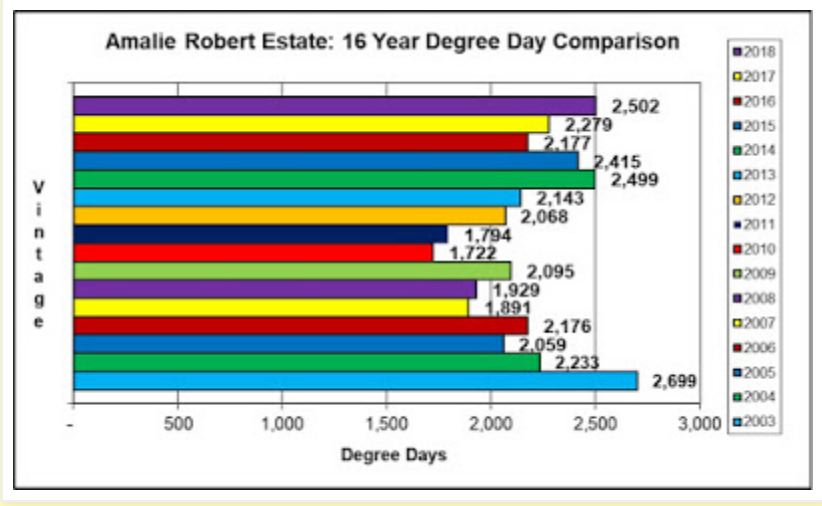 Heat summation as determined by the GDD system is not the full story with regards to vintage quality. Heat units do not take into account temperature extremes, day length, soil moisture, and timing of bud break and bloom. It is all very complicated! GDD is, however, a general measure of ripening and vintages with higher GDD such as 2003 will produce riper grapes, higher Brix and higher ABVs. Wines from the 2017 vintage are just being released into the marketplace so comparisons of the finished wines from that vintage to the wonderful 2016 offerings are preliminary. The 2017 vintage had some of the highest yields ever encountered in the Willamette Valley, in some cases 30% to 50% above expectations. It was unusual in that the vintage brought the excellent quality of fruit as well as abundance. Overall, 2017 was a cool, classic Oregon vintage, allowing sugar ripeness to stay in tune with flavor development. Harvest began three weeks later than in 2016, delivering fruit with a good balance of sugars and acids. Eugenia Keegan, General Manager for Jackson Family Wines said, “The 2017 vintage continues a five-year run of outstanding quality and is perhaps the most classic representation of the Willamette Valley in many years. These Pinot Noirs will be known for their complexity, vibrancy and longevity.” In summary, Willamette Valley Pinot Noir from the 2016 vintage is a sure bet, so stock up. Wines from the 2017 vintage are fine also and deserve your attention, but overall they will not surpass 2016. The Third-Annual Willamette: The Pinot Noir Auction, sponsored by the Willamette Valley Wineries Association (WVWA), was held on April 7, 2018, and featured 81 lots of Willamette Valley wine from the 2016 vintage (78 lots of Pinot Noir and three collaborative lots of Chardonnay). The wine, auctioned to the national and international trade, set a record of $737,000, exceeding the 2017 auction totals by 56%.
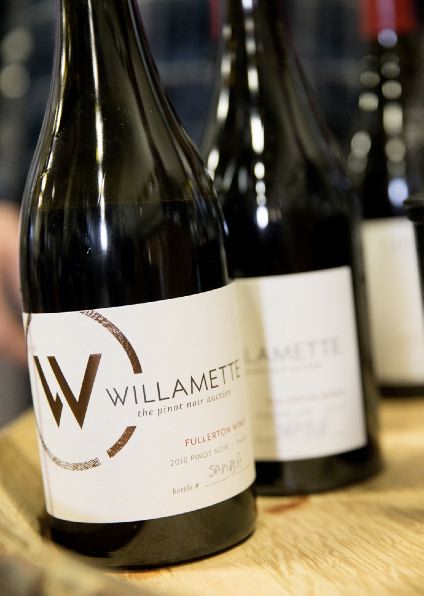 Sales of Oregon wines continue to grow. According to the Oregon Wine Board, retail store sales of Oregon’s wines rose 12.4 percent in dollar value in 2018, well above overall industry growth of 1.5 percent and California’s sales increase of 1.3 percent. Pinot Noir sales were up 15.1 percent compared to an industrywide 2.5 percent. Oregon Chardonnay dollar sales grew 14.6 percent. Oregon wines can demand higher prices because of perceived quality and with an average price of $16.29 a bottle, Oregon wines sell for more than twice the national average of $7.37.
Recently Tasted Willamette Valley Pinot Noir
Élevée Winegrowers, Dundee, ORThis winery is a Study in Willamette Valley Terroir, focused on exploring unique flavors and textures of the Willamette Valley’s diverse appellations. Winemaker and proprietor Tom Fitzpatrick believes a wine is shaped equally by one’s growing and winemaking choices. Consequently, at the heart of Élevée is the concept of ‘winegrower’ - one part ‘winemaker’ and one part ‘grower.’ The two are inextricably linked. In 2008, after a UC Davis education and years of professionally growing and crafting wines for others in Burgundy, Napa Valley, New Zealand and Oregon, Tom was presented with an opportunity to bring his idea to life when Archery Summit’s Gary Andrus decided to sell a very special, high-density site in the Dundee Hills that he had planted back in 1998. Tom purchased it and named it Élevée Vineyard. In 2016, he began directing the farming on two additional and diverse sites in the Chehalem Mountains and Eola-Amity Hills. The three vineyards are all LIVE Certified Sustainable and farmed by him. The resulting wines express the unique personality of each site and the distinct influence of each vintage, intended to exhibit the diversity and range of Willamette Valley terroir.
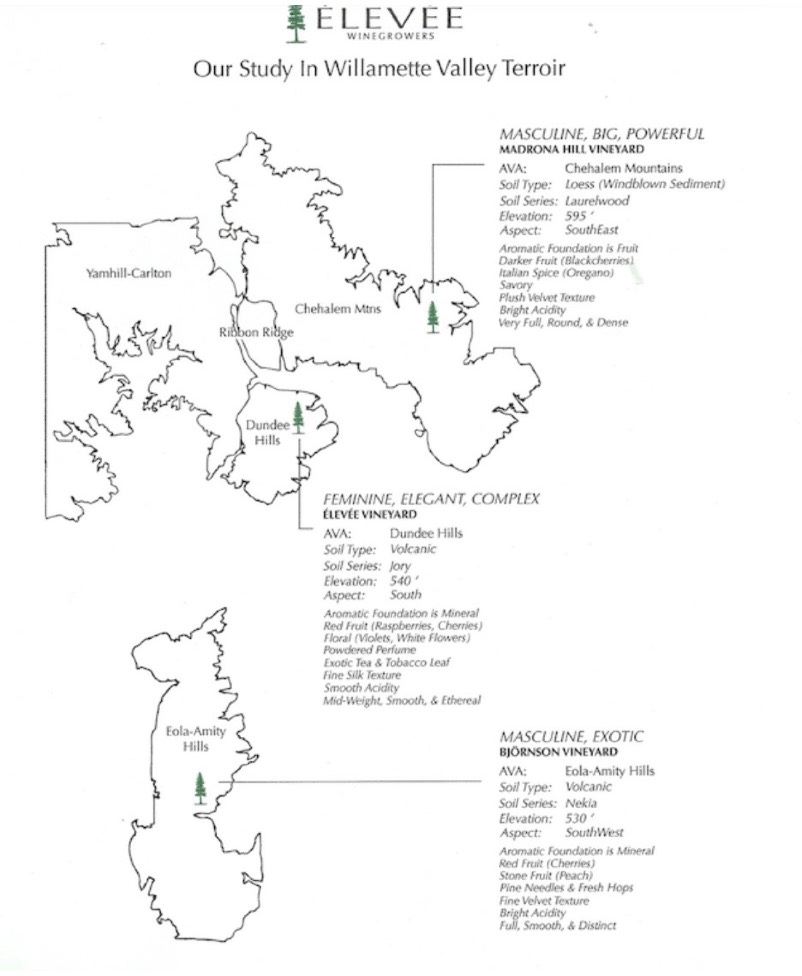 The wines are more similar than different, but given the information in the map above, one can discern terroir-driven features. The Tasting House at Élevée Vineyard is open most weekends throughout the year. Check the website at www.eleveewine.com beforehand. You can also email to make an appointment.
2016 Élevée Winegrowers Élevée Vineyard Dundee Hills Willamette Valley Pinot Noir 13.8% alc., 350 cases, $50. Released September 1, 2018. A 4-acre high-density planting in volcanic (Jory) soil. 43% 777, 43% 115 and 14% Pommard. 100% de-stemmed, 10-day cold soak, native inoculum, aged 11 months in French oak barrels, 36% new. · Moderate garnet color in the glass. Aromas of red cherry and raspberry, sandalwood and musk lead to a mid weight styled wine that is elegant in character, offering an oak-kissed cherry core. Very refined with sound acidity and a modest but satisfying finish. Much better when tasted several hours after opening as the oak reached better integration. Score: 92
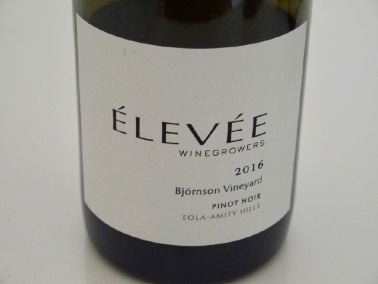 2016 Élevée Winegrowers Björnson Vineyard Eola-Amity Hills Willamette Valley Pinot Noir 14.0% alc., 300 cases, $50. Released September 1, 2018. 15-acre vineyard planted beginning in 2006 to Pommard, Wädenswil and Dijon clones in Nekia series volcanic soil. 50% 777, 50% Pommard. 100% de-stemmed, 10-day cold soak, native inoculum, aged 11 months in French oak barrels, 29% new. · Moderate garnet color in the glass. Engaging aromas of cherry, wine cask and brewed tea. Mid weight plus in concentration, with a fat core of ripe black cherry and blackberry fruits. Exceptionally good energy, with harmonious tannins and excellent finishing power. More engaging when tasted several hours after opening with better oak integration. Score: 93
2016 Élevée Winegrowers Madrona Hill Vineyard Chehalem Mountains Willamette Valley Pinot Noir 13.9% alc., 300 cases, $50. Released September 1, 2018. Vineyard consists of 19 acres planted to Pommard and Dijon clones in Laurelwood series (Loess) soil. 100% de-stemmed, 10-day cold soak, native inoculum, aged 11 months in French oak barrels, 30% new. · Moderately dark garnet color in the glass. Shy aromas of black cherry, black raspberry, and pine. Big and bold in the mouth in a mid weight plus style, offering boastful flavors of black cherry and purple berry framed by supportive tobacco oak. Nice harmony, with gracious tannins and a fruit-driven finish. Score: 92
Lenné Estate, Yamhill, ORSteve and Karen Lutz along with a group of investors launched Lenné Estate in 2002 dedicated to producing Pinot Noir from a 20.9-acre vineyard located near the town of Yamhill in the Yamhill-Carlton AVA. The Estate Vineyard is planted to Dijon clones 114, 115, 667, 777 and Pommard in shallow, low vigor Peavine (sedimentary soils). The site is steeply sloped with a south-facing aspect.
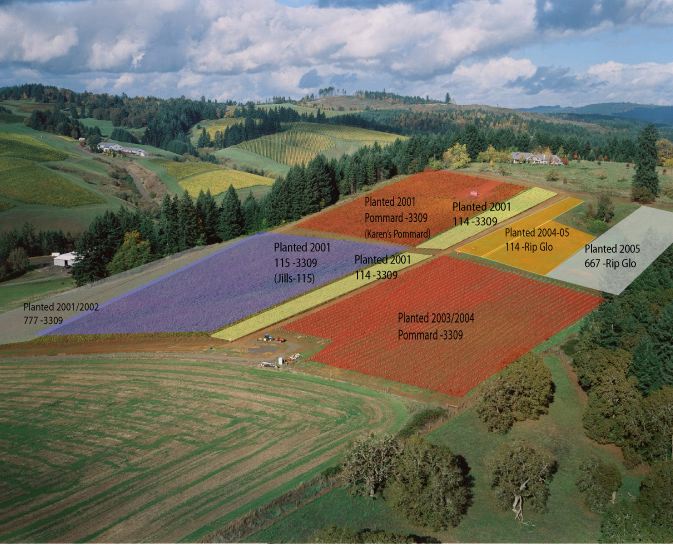 Steve is the accomplished winegrower and crafts the wines in collaboration with noted Oregon vintner David O’Reilly. Grapes are typically 100% de-stemmed, aged in French oak barrels for 10-11 months with the percentage of new oak varying but usually more in the single clone bottlings. The winery’s tasting room is open each afternoon Wednesday through Sunday and other times by appointment. The website is www.leneeestate.com. Year in and year out, Lenné Pinot Noir is about as consistently outstanding as you can find among the myriad of producers in the Willamette Valley.
2016 Lenné Le Nez Yamhill-Carlton Willamette Valley Pinot Noir 14.0% alc., 399 cases, $36. Released March 1, 2019. This wine is composed of each of the five clones planted at Lenné: 777, 114, 115, 667 and Pommard. The infant wine is generally more fruit forward than the winery’s other offerings. · Moderately dark garnet color in the glass. The nose offers a lovely mix of black cherry fruit and botanical aromas. Discreetly concentrated in a forward-drinking style, with flavors of black cherry, blackberry, black tea and earth supported by tender oak. Well-balanced with a modest finish. Score: 89
2016 Lenné Estate Yamhill-Carlton Willamette Valley Pinot Noir 14.0% alc., 350 cases, $40. Released February 1, 2019. A barrel selection of the finest parts of the estate vineyard, comprised mostly of 114 and Pommard. · Moderate garnet color in the glass. Nicely perfumed with aromas of cherry, ripe cranberry, subtle spice and rose petal. Elegant, yet flavorful, with a mid weight charge of blackberry and black raspberry fruit flavors. Less extraction than the singleclone bottlings and not as complex, but forward drinking and satisfying. There is enough tannic backbone to support several years of enjoyment. Score: 91
2016 Lenné Estate South Slope Select Yamhill-Carlton Willamette Valley Pinot Noir 14.0% alc., 250 cases, $55. Released February 1, 2019. A blend of mostly Pommard and 115. · Moderate garnet color in the glass. Soaring aromas of cherry, black plum, spice and sawdust. Impeccably balanced with excellent breeding in a mid weight style with a core of black cherry and blackberry fruit flavors. A bit reserved, becoming more engaging over time in the glass. The barrel treatment is adroit and the moderately long finish pleases. Score: 92
2016 Lenné Estate Karen’s Pommard Yamhill-Carlton Willamette Valley Pinot Noir 14.0% alc., 100 cases, $58. · Moderately dark garnet color in the glass. Aromas of well-ripened black cherry and black raspberry fruits with a hint of underbrush and cola. The boysenberry and blackberry fruits flood the mouth with goodness, yet the wine is sleek, upbeat and charming. Mid weight plus in concentration, with modest tannins and integrated oak. Somewhat reserved, and noticeably more giving when tasted the following day from a previously opened and re-corked bottle. Score: 93
2016 Lenné Estate Jill’s 115 Yamhill-Carlton Willamette Valley Pinot Noir 14.0% alc., 100 cases, $58. Released February 1, 2019. · Moderately dark garnet color in the glass. Energetic aromas of spiced cherry and complimentary toasty oak. The pretty black cherry and black raspberry core caresses and envelopes the palate in a scintillating fashion. This wine really grabs your attention. Impressive concentration, yet bright and vigorous, with nuanced additional flavors of orange Pekoe tea and mocha. The mouthfeel is satiny and the finishes displays both intensity and length. Score: 94
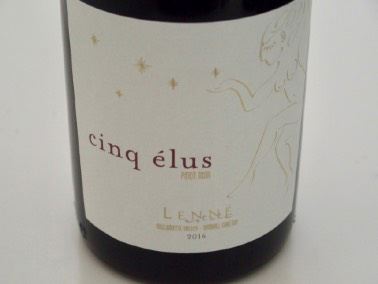 2016 Lenné Estate Cinq Élus Yamhill-Carlton Willamette Valley Pinot Noir 14.0% alc., 125 cases, $78. A blend of the best barrel from each of the five estate clonal blocks. · Moderately dark garnet color in the glass. The nose is the most seductive in the 2016 lineup, offering the scent of juicy, pure blackest cherry. The chorus of ripe and expansive black raspberry and blackberry fruit along with the supportive, juicy acidity is utter contentment . A complete wine with exemplary harmony, leaving behind an extremely long trail of of black cherry goodness. As good as this wine is now, it is an ideal cellar candidate and would be an ideal centerpiece for a special dinner in the future. Score: 95
Privé Vineyard, Newberg, ORMark and Tina Hammond report that 2017 was an exceptional growing season for them in the Chehalem Mountains. The summer months had plenty of warmth, but the 38-year-old Pommard clone vines are late to ripen, allowing for longer hang time and excellent fruit development. The 2-acre vineyard is divided into northern (Le nord) and southern (Le sud) sections.
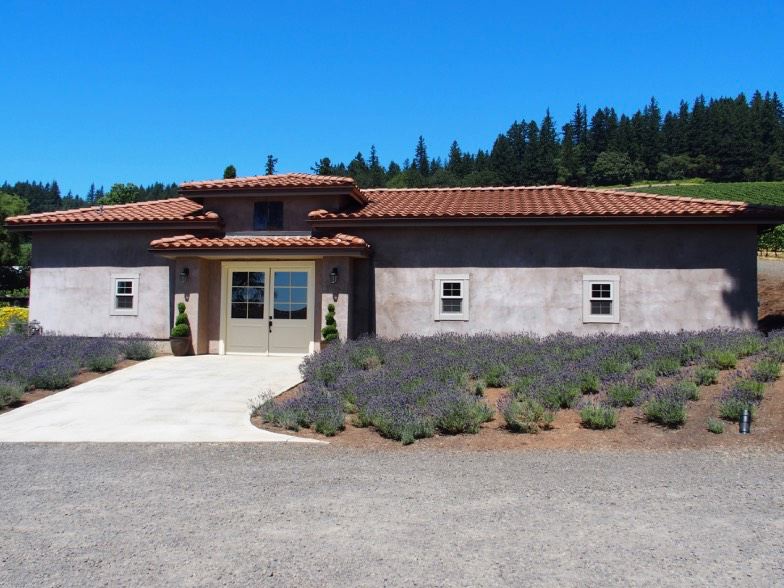 My experience, confirmed by the Hammonds, has been that these wines drink best after one year in bottle and ideally three years for a real leap in development. The reviews below should be taken in this context and undoubtedly will be even more engaging with more time in the cellar. Privé Vineyard is a members-only winery. Members are welcome by appointment. Non-members can visit if referred by a member. Inquire at info@privevineyard.com. Those on the allocation list can now place orders online through the website at www.privevineyard.com. Beautifully etched magnums ($160-$240) are available. In addition to the wines reviewed here, the winery offers a Chehalem Mountains AVA Pinot Noir and a Ruby Pinot Port.
2017 Privé Vineyard Le sud Chehalem Mountains Willamette Valley Pinot Noir 13.8% alc., $75. · Moderately light garnet color in the glass. Aromas of Bing cherry, bakery and underbrush. Sleek and silky in the mouth in an elegant and lacy mid weight style, displaying flavors of dark red and black cherry and blueberry with a dusting of toasty oak. The finish is striking with waves of pure cherry righteousness. Still young and showing barrel dress, showing much better oak integration when tasted the following day from a previously opened and re-corked bottle. Give this wine a year or two. Score: 93
2017 Privé Vineyard Le nord Chehalem Mountains Willamette Valley Pinot Noir 13.7% alc., $65. · Light ruby red color in the glass. Vibrant aromas of Bing cherry and rose petal. Very similar to Le sud but with a bit more extraction and dusting of oak. Middleweight styled, with seductive elegance, offering flavors of dark red and purple berry fruits with a pinch of spice. Juicy, with inviting harmony and a generous cherry-driven finish. Wait a year or two on this wine for full enjoyment. Score: 93
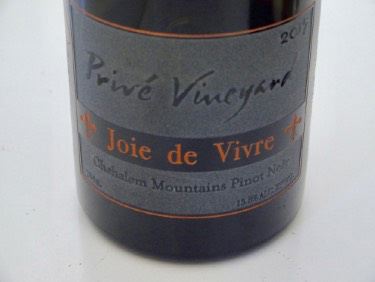 2017 Privé Vineyard Joie de Vivre Estate Chehalem Mountains Willamette Valley Pinot Noir 13.8% alc., 300 magnificently etched and signed bottles, $105. · Moderately light garnet color in the glass. The very deep cherry aroma is complimented by gracious oak. A step up in hedonism, offering a mid weight charge of darker cherry and purple berry fruits that saturate the palate. Plush and expansive in the mouth, yet still feminine in demeanor, with valued inherent structure. The texture is seductively smooth and the finish is ridiculously long. When tasted the following day from a previously opened and recorked bottle, my notes say “Mind-boggling!” Score: 95
Red Electric Wines, Amity, ORThis winery is a collaboration between winemaker John Grochau and winegrower Douglas Ackerman, owner of Armstrong Vineyard. John is the winemaker and owner of Grochau Cellars in Amity, Oregon. His winemaking experience includes stints at Erath Winery and Brick House Vineyards. The winery name is derived from the Red Electric commuter trains that carried passengers from Portland to the communities of the Willamette Valley. Many of these communities are now intimately associated with Oregon Pinot Noir including Sherwood, Newberg, McMinnville, Forest Grove, Carlton, Salem and Eugene.
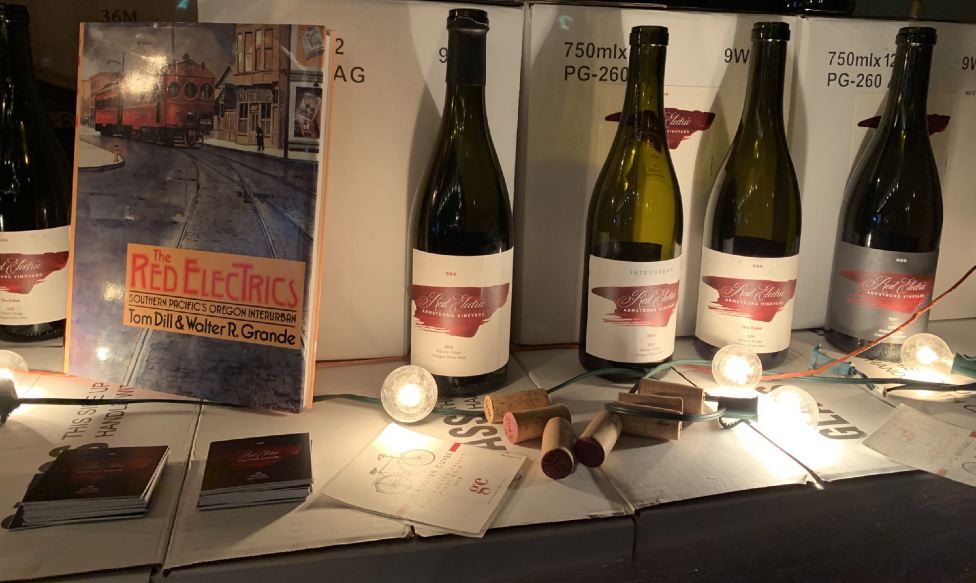 The Armstrong Vineyard was established in 2007 by Doug and Michele Ackerman in the Ribbon Ridge AVA and has been farmed organically since 2013. Soils are the classic ancient sedimentary Willakenzie series found in this AVA. The planted clones include Pommard, Wädenswil, and Dijon 114, 115, 667 and 777. In 2017, one acre was grafted over to Chardonnay, primarily Mt Eden clone, with scion wood sources from Cameron and Johan wineries. During the first five years of grape production, the fruit was sold to local wineries including Native Flora, Seven of Hearts, Cameron and Ayres. Pinot Noir winemaker principles include a moderate use of whole cluster fermentation when stems are optimally lignified, native yeast fermentation, acidulation only when necessary, and limited use of new oak barrels. For more details on Red Electric or to purchase wine, email redelectricwines@gmail.com.
2016 Red Electric Armstrong Vineyard Interurban Ribbon Ridge Willamette Valley Pinot Noir 13.77% alc., 300 cases, $28. 12% whole cluster fermentation. Natural yeast fermentation. 25% Pommard, 20% 777, 20% 115, 20$ 667 and 2% Wädenswil. Aged in French oak barrels, 5% new. · Moderately light garnet color in the glass. Shy, but pleasant aromas of black cherry, rose and damp earth. Light to mid weight nucleus of earth-kissed cherry and red candy flavors. Juicy acidity, with silky tannins and well-mannered oak. Score: 90
2016 Red Electric Armstrong Vineyard The Pulse Ribbon Ridge Willamette Valley Pinot Noir 13.79% alc., 200 cases, $50. 9 special barrels consisting of 30% Wädenswil, 30% 115, 10% 667, 10% Pommard and 10% 114. Natural yeast fermentation, 18% whole cluster. Aged in French oak barrels, 15% new. · Moderate garnet color in the glass. A mix of dark cherry and berry are offered on the nose and on the palate in a mid weight style. A thread of dried herbs and botanical input add interest. Very good energy, with a modestly firm tannic backbone and a chewy finish. Score: 92
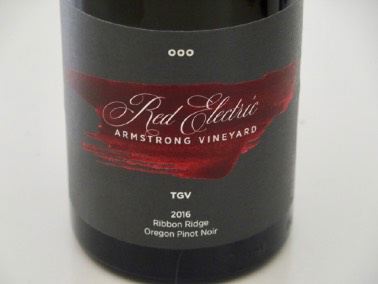 2016 Red Electric Armstrong Vineyard TGV Ribbon Ridge Willamette Valley Pinot Noir 13.74% alc., 100 cases, $70. Only made in special vintages. 4 special barrels. Natural yeast fermentation, 25% whole cluster, aged in French oak barrels, 30% new. · Moderate garnet color in the glass. The nose opens slowly over time in the glass, revealing opulent aromas of dark red and black fruits. Delicious dark red and black cherry and black raspberry flavors envelope the palate. A classy wine that is nicely composed, with lively acidity, suede tannins and a persistent finish filled with cherry delight. Somewhat reserved, and deserving of more time in the cellar. Score: 93
Sylvanus Estate, Yamhill, ORA new, promising discovery for me, Sylvanus Estate is a small family vineyard located in the foothills of the Coast Range. The vineyard has a unique microclimate, situated at the very western edge of the Yamhill-Carlton AVA in Moores Valley, with cooler temperatures and more days of sunshine than typical Yamhill-Carlton sites. It is the only vineyard in Moores Valley. Sylvanus means “Of the Forest” in Latin, an appropriate name for a vineyard surrounded on three sides by Oregon Firs. The 25-acre site contains three planting blocks, eight different soil series and rises from around 450 feet to 700 feet elevation. The first “Home Block” of Pinot Noir was planted in 2013, followed by “Willow Pond Block containing white grapes and Pinot Noir, and lastly, “The Walnut Grove Block.” The winery proprietors are Christian and Lisa McDonald Eddleman, sixth and seventh generation Texans, whose love of Pinot Noir led them halfway a ross the world to study viticulture and enology at Lincoln University in New Zealand. After working in the wine industry in New Zealand, they were led back to Oregon as they considered it the most suitable place to make Pinot Noir. Consulting winemaker Drew Voit says that the Sylvanus Estate Vineyard offers the highest level of stem lignification he has ever seen in the Willamette Valley so he employs significant whole cluster fermentation in some of the Estate wines.
I have written extensively about the use of whole cluster fermentation in the vinification of Pinot Noir and I am a fan of its benefits. I recently read the results of an investigation by Anthony Fikkers proprietor and winemaker of small Yarra Valley wine producer Fikkers Wines at www.winetitles.com.au. In 2018, Fikkers looked at the use of whole cluster fermentation in Burgundy, Beaujolais and the Rhone Valley in France using a travel scholarship. His conclusions are presented here. Many of the producers told Fikkers that using whole clusters in red fermentation brings freshness and personality to their wines. French vintners cited other advantages including the creation of uniqueness and the merger of fruit and tannin giving wines a more seamless character. Most of the producers use the oldest vine parcels for whole cluster fermentation because the old vines produce the smallest bunches and berries. Many producers said that not all vineyards produce fruit suitable for whole cluster fermentation due to naturally high tannins. For example, at Domaine Cecile Tremblay in Burgundy, Cecile Tremblay does not use whole clusters in her wines from Nuits Saint-George because the vineyards are already very tannic, but in Chambolle Musigny she uses 100% whole clusters because the approach suits the terroir. Most producers who use less than 100% whole cluster mix whole clusters and de-stemmed fruit through the fermenter. They destem the more inferior fruit found at the sorting table. A small number of producers put whole clusters on the bottom of the fermenter, but no one put them on top of the ferments. Several producers avoid adding sulfur dioxide to fruit, particularly before fermentation, feeling that sulfur can harden tannins, particularly stem tannins, which can result in a hard, unbalanced wine. A Burgundy domain with a long history of 100% whole cluster fermentation is participating in a trial with a major university in France, comparing the tannin profiles of 100% whole cluster wines with wines from completely de-stemmed fruit. The whole cluster barrels show more energy and purity, with tannin supporting the fruit, while the de-stemmed wine was much more tannic. A higher concentration of certain tannins in the whole cluster wines was found to taste sweet. This study, while not completely disclosed, may challenge the current accusation of whole-cluster haters that claim the technique will only result in harsh, green tannins. All Sylvanus Estate wines are considered barrel select wines. The Cipher bottling displays a unique cipher encircling the printer’s mark. With cleverness, patience and an understanding of its story, the cipher is solvable. ,p> Vineyard tours and tastings are available by appointment. The wines are highly allocated due to very limited quantities. Visit www.sylvanusestate.com.
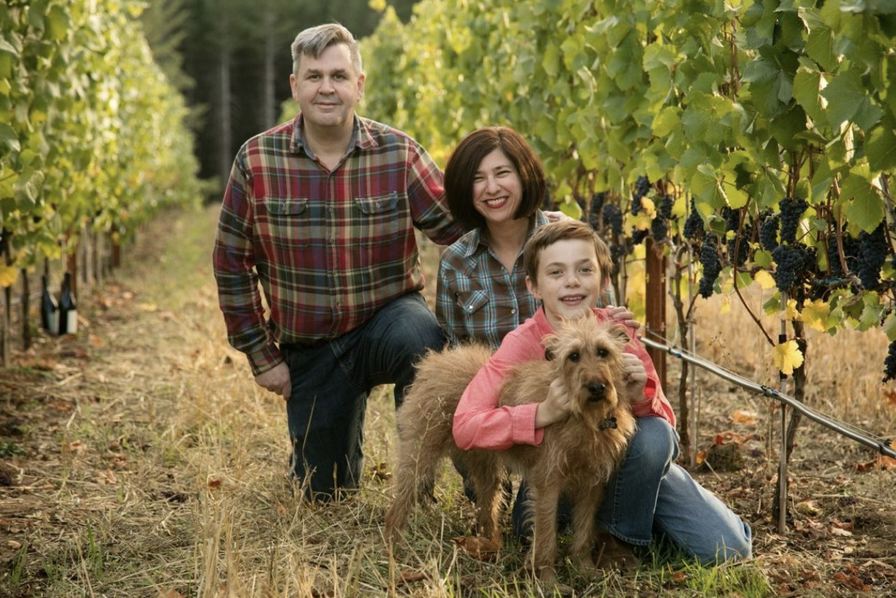
2016 Sylvanus Estate Yamhill-Carlton Willamette Valley Pinot Noir 13.9% alc., 75 cases, $50. A blend of Pommard, 115, 777 and Mt Eden clones. Aged in French oak barrels, 25% new. · Moderately dark garnet color in the glass. Plenty of garrigue and forest on the nose along with black cherry aromas. Well-structured and well-endowed in a mid weight plus style, with waves of purple and black berry fruits. Almost numbing intensity, with a serious attack and purposeful and long finish. The wine has a Syrah-like countenance but is so well put together, it still speaks more of Pinot Noir. Score: 93
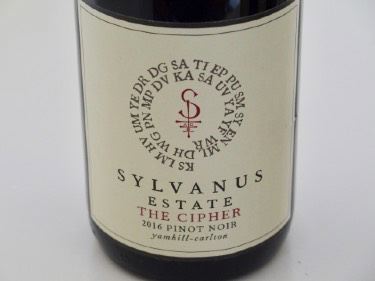 2016 Sylvanus Estate The Cipher Yamhill-Carlton Willamette Valley Pinot Noir 13.9% alc., 50 cases, $65. 50% whole cluster Pommard and 50% co-fermented 115, 777 and Mt Eden clones. Aged in French oak barrels, 50% new. · Moderately dark garnet color in the glass. The savory nose is driven by aromas of fertile earth and sous-bois. Similar to the regular estate bottling, but with more brightness, energy, refinement and polish. Spirited and delightful, featuring an array of dark fruits creating a bold imprint on the palate. There is some wild game character that intrigues. Blessed with a bold, but agreeable tannin structure, this wine will hold its own for many years to come. Score: 94
2017 Sylvanus Estate Yamhill-Carlton Willamette Valley Pinot Noir 13.5% alc., 125 cases, $50. A blend of Pommard, 777 and Mt Eden clones. Aged in French oak barrels, 40% new. · Moderately dark garnet color in the glass. Leading off are aromas of black cherry, fertile earth, floral perfume and smoky potpourri reaching new heights over time in the glass. The mid weight nucleus of dark red cherry and berry fruits enter with purpose. Plush in the mouth and engaging, with sleek tannins, supportive oak, a touch of earthiness, and a civilized, slightly tart cherry finish. Much better when tasted the following day from a previously opened and re-corked bottle. Score: 91
2017 Sylvanus Estate The Cipher Yamhill-Carlton Willamette Valley Pinot Noir 13.5% alc., 75 cases, $65. 100% whole cluster Pommard clone. Aged in French oak barrels, 66% new. · Moderate garnet color in the glass. Enjoyable aromas of black fruits and fertile soil arrive over time in the glass. A middleweight wine with personality, offering flavors of earth-kissed purple berries and the slightest dusting of oak. Silken in texture, with good energy, firm but not aggressive tannins, and a modest, plum-driven finish. Unchanged when tasted the following day from a previously opened and re-corked bottle. Score: 92
2017 Sylvanus Estate Home Block Yamhill-Carlton Willamette Valley Pinot Noir 13.6% alc., 75 cases, $65. Pommard, 777 and 115/MtEden (co-ferment) clones in equal measure. No whole cluster. Aged in French oak barrels, 66% new. · Moderate garnet color in the glass. Pleasing aromas of cherry pie and sous-bois lead to a mid weight styled wine exhibiting uncommon polish and elegance. The flavors of dark red and purple fruits are bottomless and carry over through a very persistent finish. The oak is beautifully integrated, and the tannins are very agreeable. When tasted the following day from a previously opened and re-corked bottle, the finish still stood out as extraordinary. Score: 93
California Pinot Noir to Swoon Over
The art of describing tasting experiences with exalted domestic Pinot Noir is a real challenge. Lisa Perrotti- Brown said, “It is incredibly difficult, arduous and time-consuming to rack up the level of experience necessary to review and score wines with consistency.” Not only that, even well-trained wine critics are not paid much for what they do. All that said, it is the non-monetary and inspirational benefits that are most valuable to those fortunate enough to experience the current crop of domestic Pinot Noir wines. Besides, someone has to be an arbitrator of taste. Many of the California wines reviewed here are infused with a level of meaning that no other beverage can offer and several of these Pinots stole my heart. Hopefully, readers will experience some of these wines and try to understand and even describe how Pinot Noir creates magic in a glass.
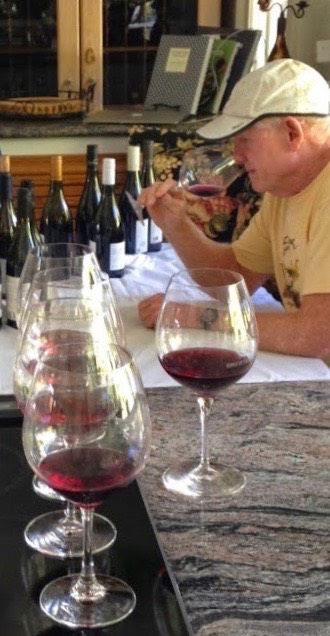
Bohème Wines, Occidental, CASonoma Coast Pinot Noir and Chardonnay crafted by proprietor and 5th generation winemaker Kurt Beitler since 2004. Kurt leases three Pinot Noir vineyards located in the vicinity of the town of Occidental and are among the nearest vineyards to the Pacific Ocean in all of North America. Check out www.bohemewines.com.
2015 Bohème English Hill Vineyard Sonoma Coast Pinot Noir 13.7% alc., 235 cases, $55. Released November 1, 2018. Vineyard is a mosaic of Pinot Noir, Chardonnay and Syrah surrounded by pasture and rangeland overlooking Tomales and the Marin Coast Range 9.2 miles from the Pacific Ocean. 8.5 acres planted to Pinot Noir clones 115, 667, Calera and a Vosne-Romanée selection in Goldridge sandy loam and Steinbeck sandy loam soils. Average yield of 1.22 tons per acre. This wine is a barrel selection of four vineyard blocks.25% whole cluster fermentation. Aged 22 months in French oak barrels, 15% new. · Moderately light garnet color in the glass. I love the nose. Aromas of dark cherry, black raspberry liquor, sous-bois and a hint of vanilla. Luscious dark red and black berry and black cherry fruits hug the palate. A husky, but facile mid weight wine with silky tannins and a sensual texture. More cherry shows up on the finish. A bit of oak-driven char and cola chimes in. Score: 93
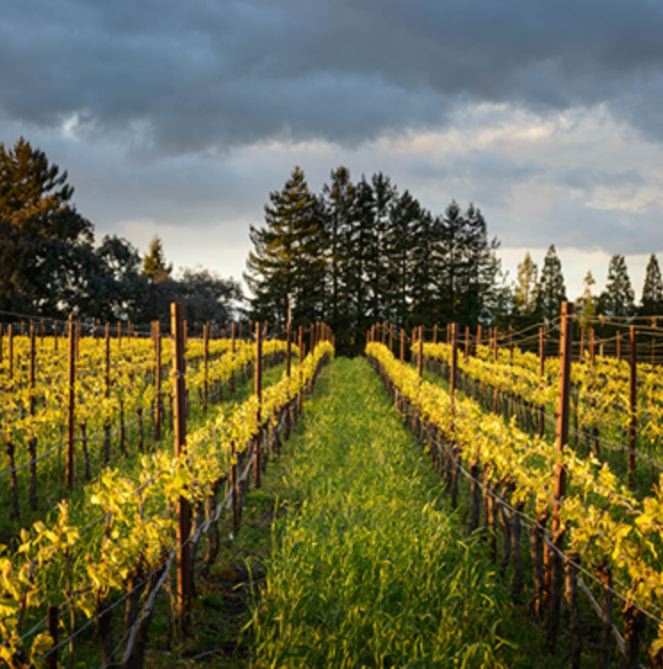
2015 Bohème Taylor Ridge Vineyard Sonoma Coast Pinot Noir 13.7% alc., 105 cases, $55. Released November 1, 2018. A 4.9-acre vineyard planted in 1999, 5.3 miles from the Pacific Ocean. Swan clone. Goldridge sandy loam soil. Yield 0.65 tons per acre. 18% whole cluster. Aged 22 months in French oak barrels, 15% new. · Moderate garnet color in the glass. Aromas of blackberry reduction, baking spices, floral bouquet and sweaty shirt combine in the glass. Dense and bold in a mid weight plus style featuring earthy black berry and black cherry fruits. A big boy wine with firm, ruddy tannins and a big, fruit-filled and lasting finish. Much more appealing when tasted the following day from a previously opened and re-corked bottle again showing a glorious finish. Score: 93
2015 Bohème Stuller Vineyard Sonoma Coast Pinot Noir 13.5% alc., 144 cases, $55. Released November 1, 2018. A 6.0-acre vineyard planted in 1998 5.8 miles west of the Pacific Ocean. Dijon 115 and 667 clones. Diverse clay loam soils. Yield 0.41 tons per acre. 30% whole cluster fermentation. Aged 22 months in French oak barrels, 17% new. · Dark garnet color in the glass. Aromas of black cherry and marzipan are shy but pleasant. Very ripe flavors of black raspberry, blackberry and cherry nougat. The succulent fruit makes an impression on the mid palate and lip-smacking finish that features an onslaught of fruit. More enjoyable when tasted the following day from a previously opened and re-corked bottle, exhibiting a suave mouthfeel and a very big finish. Score: 92
Furthermore Wines, Sebastopol, CAThis winery began in 2006 in San Francisco’s Crushpad, shifting to an urban winery in San Francisco, and with the purchase of Graton Ridge Cellars of Sebastopol in 2016, operations moved to that location. Production is now 5,000 cases. I first encountered the winery’s 2008 vintage wines at Pinot Days and have followed their success since that time. Proprietors Chad Richards and Bob Zeches employ Erica Stancliff as head winemaker. Check out the winery at www.furthermorewines.com and www.princeofpinot.com/winery/ 1018/. The following wines will be released in April 2019.
2015 Furthermore Graton Ridge Vineyard Russian River Valley Pinot Noir 14.1% alc., 106 cases, $55. An Estate vineyard located at the winery and just outside the tasting room, sharing a fence with neighbor Paul Hobbs. Clones are Dijon and Pommard. · Moderately dark garnet color in the glass. A savory nose offers aromas of black olive, rose petal, dusty underbrush, pipe smoke and cherry. Cherry fruit cola and savory herb flavors combine in this middleweight offering with silky tannins and a compliment of toasty oak. This flirtatious wine gives up more enjoyment with more time in the glass. Score: 90
2015 Furthermore Nevina’s Vineyard Sonoma Coast Pinot Noir 13.1% alc., 60 cases, $60. The winery’s Occidental estate vineyard located less than 6 miles from the Pacific Ocean at an elevation of 1,300 feet. The vineyard was planted in 2002 with 777 clone by Sonoma Coast Pinot Noir pioneer Scott Zeller who nurtures the vineyard. In 2012, an additional block of 667 clone was added. Yields are a painfully low 1 ton per acre. Clones 777 and 667. · Moderately dark garnet color in the glass. Aromas of black cherry, violets, bramble and woodshed. Discreetly concentrated flavors of black cherry, black raspberry and boysenberry with a compliment of oak in the background. Silken in texture with gentle tannins and a modest finish. Score: 91
2015 Furthermore Gioia Vineyard Sonoma Coast Pinot Noir 14.0% alc., 106 cases, $55. This vineyard is nestled in the redwoods in Occidental about 7 miles inland from the Pacific Ocean. Replanting took place in 1998. The steep, rocky terrain makes this vineyard a labor of love to farm. Clones are 33% 113 and 67% Pommard. · Moderately dark garnet color in the glass. Nicely perfumed with scents of ripe cherry, strawberry and floral goodness. Mouth filling mid weight flavors of spiced black cherry and fruit punch. Excellent harmony and purity of fruit with a healthy tannic backbone and plenty of finishing purpose. Score: 92
2015 Furthermore La Encantada Vineyard Sta. Rita Hills Pinot Noir 13.6% alc., 151 cases, $50. This organically-farmed vineyard was planted by Santa Barbara County Pinot Noir icon Richard Sanford. Clones 115, 667, and 777. · Moderately light garnet color in the glass. Enticing aromas of dark red cherry and berry, exotic spices, pipe smoke and toast. Impressive energy in a mid weight style offering flavors of blueberry and black raspberry with a thread of oak. Nicely balanced and easy to approach, with a modest but satisfying finish. Best several hours after opening. The wine’s best feature is the vivacious acidity. Score: 92
2015 Furthermore Starbridge Vineyard Sonoma Coast Pinot Noir 13.1% alc., 20 cases, $75. Starbridge Vineyard was originally part of Summa Vineyard, split off by Scott and Joan Zeller when Thomas Brown bought and retained the name of Summa Vineyard. This 2-acre plot is located on Taylor Lane in Occidental just 5 miles from the Pacific Ocean. · Light ruby red color in the glass. The nose is not particularly flattering, offering aromas of red cherry, cranberry, sandalwood, dried herbs and tobacco leaf. Light in weight and delicately styled, featuring lacy red fruits and a stream of savory flavors including weedy underbrush and tobacco. A cozy wine with gossamer tannins, but the barrel treatment supersedes the demure, even dilute fruit core. No change when tasted the following day from a previously opened bottle. Tasted twice with consistent results. Score: 89
Morgan Winery, Salinas, CAA top-shelf winery founded by Daniel Morgan Lee in 1982 with the first Pinot Noir release in 1988. This producer of Pinot Noir and Chardonnay from the Santa Lucia Highlands has been named “Winery of the Year’ by both Wine & Spirits magazine and the San Francisco Chronicle. The wines are always dependable and frequently outstanding. For more information, visit www.morganwinery.com and www.princeofpinot.com/ article/1993/.
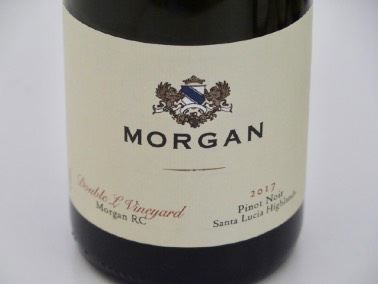 2017 Morgan Double L Vineyard Clone RC Santa Lucia Highlands Pinot Noir 14.0% alc., pH 3.56, TA 0.66, 100 cases, $65. Cuttings smuggled from a very famous vineyard in Burgundy were grafted to a small block at the top of the estate Double L Vineyard. Organic grapes were 100% destemmed. Native yeast induced whole berry fermentation in open top tanks. Aged 11 months in French oak barrels, 45% new. · Light ruby red color in the glass. Bright aromas of cherry, spice and sous-bois. Light to mid weight in concentration and elegant in style, with flavors of red cherry, raspberry and cranberry with an accent of spice and botanical goodness. A dreamy, feminine wine with terrific balance and oak management that aims to please out of the chute. Score: 94
Neely Wines, Portola Valley, CAA few issues back, I portrayed Dr Kirk Neely and his Pinot Noir and Chardonnay wines from the Spring Ridge Vineyard. The two additional releases from the 2016 vintage are terrific and reviewed here. These wines and the Chardonnays reviewed elsewhere in this issue are part of the 2019 spring release. The previously reviewed 2015 vintage wines were transitional in that the grapes left the vineyard and were crushed in San Francisco under the direction of Shalini Sekhar, Neely Wine’s second-generation winemaker. In 2016, the grapes never left the vineyard until delivered to a warehouse in bottle. The 2016 vintage is a homecoming and the beginning of a revised finesse and understanding. The Pinot Noirs, in particular, are a step up. The wines will be released March 25, 2019. Visit www.neelywine.com or www.princeofpinot.com/article/2156/.
2016 Neely Picnic Block Spring Ridge Vineyard Santa Cruz Mountains Pinot Noir 13.6% alc., 98 cases, $48. · Moderately light garnet color in the glass. Lovely aromas of cherry, strawberry and sous-bois. A complex wine with earth, botanical, animale and black cherry and ripe strawberry fruit flavors. This wine has inviting energy and juiciness, integrated sweet tannins, a soothing texture and a succulent cherry-driven finish of notable persistence. Score: 93
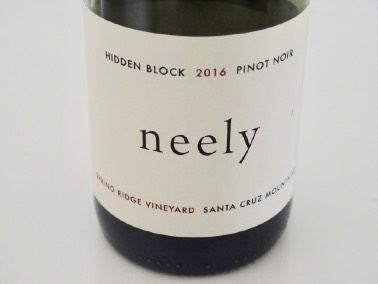 2016 Neely Hidden Block Spring Ridge Vineyard Santa Cruz Mountains Pinot Noir 14.0% alc., 98 cases, $48. · Moderately light garnet color in the glass. Demure, but very pleasant aromas of cherry and fertile earth. A complete wine featuring mid weight flavors of dark cherry and dark berry blessed with an underlying earthy tone. Gracious tannins and ingratiating acidity make for an uplifting drinking experience. The fruit in this beautifully composed wine has an uncommon brightness and charm. Every Pinot connoisseur will love the lip-smacking finish. Score: 94
ROAR Wines, San Francisco, CAROAR Wines is owned by Gary and Rosella Franscioni, who also own the nearby Garys’ Vineyard, Soberanes Vineyard in partnership with the Pisoni family, and are the sole owners of Rosella’s Vineyard and Sierra Mar Vineyard. Pictured below are the two famous Garys, Gary Pisoni (left) and Gary Franscioni.
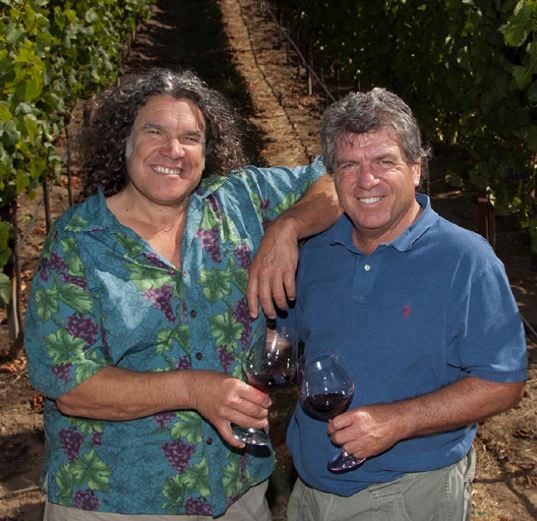 Winemakers Gary Franscioni and his son Adam are now crafting wines from the Santa Lucia Highlands that are among the elite of this appellation. I missed the 2016 vintage wines, but these 2017 vintage releases are full of personality. The grapes for the Pinot Noir wines are picked on the ripe side resulting in higher ABVs and aged in significant new oak, but the resulting flamboyantly-fruited wines are beautifully balanced and although young, are easily approachable now. Visit www.roarwines.com or www.princeofpinot.com/article/1921/.
2017 ROAR Santa Lucia Highlands Pinot Noir 14.8% alc., pH 3.79, TA 0.58, 1,670 cases, $45. Clones 23, 667, 777, 943, Calera, Pisoni, Pommard and Swan. Aged in French oak barrels, 41% new. · Moderate garnet color in the glass. Soaring aromas of black cherry, red currant and fertile earth. Light to mid weight in style, offering a satisfying spiced cherry core. Forward drinking, with exquisite balance and a modest finish. This wine says, “smell me, swirl me, drink me!” Score: 91
2017 ROAR Rosella’s Vineyard Santa Lucia Highlands Pinot Noir 14.8% alc., pH 3.74, TA 0.59, 710 cases, $62. Clones 23, 113, 667, 777, Pisoni and Pommard. Aged in French oak barrels, 65% new. · Moderately dark garnet color in the glass. Enticing aromas of dark red cherry, baking spices and toasty oak. The nucleus of black raspberry and blackberry fruits really impresses in the mouth. Good harmony, with gracious tannins, integrated alcohol, and some finishing purpose. Score: 92
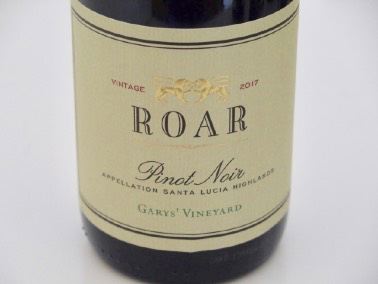 2017 ROAR Garys’ Vineyard Santa Lucia Highlands Pinot Noir 14.9% alc., pH 3.77, TA 0.58, 756 cases, $62. Calera and Pisoni clones. Aged in French oak barrels, 68% new. · Moderately dark garnet color in the glass. Aromas of dirty cherry and complimentary toasty oak. The dark cherry fruit literally explodes on entry in the mouth, holding an expansive court through the mid palate and finishing long and gratifying. Impeccably crafted, with relaxed tannins, deft oak integration and a seamless demeanor. This is a very sensual wine from a special vineyard that delivers uncommon virility with charm. You will want some of this. Score: 95
2017 ROAR Soberanes Vineyard Santa Lucia Highlands Pinot Noir 14.8% alc., pH 3.79, TA 0.58, 297 cases, $58. Clones 667 and Pisoni. Aged in French oak barrels, 67% new. · Moderate garnet color in the glass. Lovely aromas of black cherry, purple berry, and chocolate nougat. Very bright in the mouth, with uplifting flavors of dark cherry and boysenberry. Seamless in composure, with easygoing tannins, leaving behind a dreamy boysenberry memory. Score: 93
2017 ROAR Sierra Mar Vineyard Santa Lucia Highlands Pinot Noir 14.8% alc., pH 3.78, TA 0.59, 686 cases, $58. Clones 943, Calera, Swan and Pisoni. Aged in French oak barrels, 71% new. · Moderate garnet color in the glass. Pleasing aromas of blackberry, cassis, underbrush and a hint of toasty oak. The tasty mid weight core of black cherry and blackberry fruits entices. There is a note of dark chocolate. The silken tannins are handsome, toasty oak plies the background with finesse, and the wine finishes with good intensity. Very solid, if not superb. Score: 93
2017 ROAR Pisoni Vineyard Santa Lucia Highlands Pinot Noir 14.7% alc., pH 3.69, TA 0.58, 365 cases, $75. Pisoni clone. Aged in French oak barrels, 60% new. · Moderately dark garnet color in the glass. The nose reluctantly opens slowly over time to reveal deep aromas of dark fruits and sous bois. Exceptionally pure and intense black cherry fruit with appealing spice, iron and animale undertones. A harmonious edition, with suave tannins, ideal oak integration, and a finish filled with joyous appeal. A consummate connoisseur’s wine that will gain traction with more time in the cellar. Score: 94
Roger Roessler Wines, Sonoma, CAIn 2015, Roger Roessler Wines celebrated fifteen years of winemaking. This winery is a partnership between brothers Roger and Richard Roessler. Phil Staehle, owner of Enkidu Winery, has been producing Roger Roessler wines for the past few years, but the winemaker since 2016 has been Drew Huffine. The winery’s focus is on Pinot Noir from Sonoma Coast vineyards. The Roger Roessler Wine Company brands include Black Pine, Roessler Cellars, R2 Wine Company and Roger Roessler Wines. For more information, visit www.rogerroesslerwines.com.
2017 Roger Roessler Wines Black Pine Sonoma Coast Pinot Noir 14.2% alc., pH 3.74, TA 0.56, $30. Sourced from three vineyards in the western Russian River Valley, Carneros and the Petaluma Gap. Native and organic french yeast driven fermentation. Aged 10 months in French oak barrels, 20% new. · Dark garnet color in the glass. Aromas of boysenberry, blackberry, wine cave and fertile earth with a hint of volatile acidity. Full-bodied in style with a full monty of purple and blackberry fruits backed by well structured tannins. Lower in acidic verve with a well-managed compliment of oak and a generous fruit-filled finish. What this wine lacks in nuance and finesse, it makes up for it in decadent fruit. Score: 90
2016 Roger Roessler Wines Bogey Vineyard Sonoma Coast Pinot Noir 14.1% alc., pH 3.68, TA 0.59, 158 cases, $50. 100% de-stemmed, organic French yeast, aged 11 months on the lees in French oak barrels, 25% new. · Moderate garnet color in the glass. The aromas are primarily oak-driven, with black cherry in the background. Fresh and juicy, with good vim and vigor, in a mid weight gracious and calming style. That said, the uplifting nature is tempered by intrusive oak. Score: 89
2016 Roger Roessler Wines Lennox Vineyard Russian River Valley Pinot Noir 13.9% alc., $60. Sourced from a 2-acre vineyard located in Sebastopol on the western reaches of the Russian River Valley. Clones 667, 777 and 115 fermented separately.Organic yeasts. Aged 18 months in French oak barrels, 25% new. · Moderately light garnet color in the glass. Aromas of Bing cherry and sweet pipe smoke lead to a mid weight styled wine with flavors of well oaked black cherry and cola. Juicy, with an appealing soft texture, but hard to get by the oak. Score: 88
2016 Roger Roessler Wines Hein Vineyard Anderson Valley Pinot Noir 13.8% alc., pH 3.95, TA 0.53, 121 cases, $54. Vineyard located in the deep northwestern end of the Anderson Valley. Native yeast fermentation. Aged 11 months in French oak barrels, 25% new. · Moderately light garnet color in the glass. Aromas of very ripe, dark fruit and espresso lead off. The core of black cherry and blackberry fruits pushes the ripeness envelope. The tannins are well corralled and the slightly tart cherry finish is quenching. When tasted the following day from a previously opened and re-corked bottle, the nose was heavily imbued with nutty oak and the palate experience was unchanged. Score: 88
2016 Roessler Wine Cellars 3bbl Sonoma Coast Pinot Noir 14.4% alc., $N/A. 3 barrels in part from Sangiacomo Roberts Road Vineyard. · Moderately dark garnet color in the glass. The nose features very ripe, stewed dark fruit and marzipan aromas. Full-bodied, the a core of roasted dark cherry, berry, plum and raisin flavors. The slightest alcoholic heat shows up on the finish. Score: 86
Schermeister Winery, Glen Ellen, CAProprietor and winemaker Robert Schermeister developed his skills as an assistant to noted winemakers Mark Aubert and Jayson Pahlmeyer. He crafts limited production wines from Napa Valley and Sonoma County. A tasting room is located in Jack London Village in Glen Ellen. Visit www.schermeister.com or www.princeofpinot.com/article/2441/.
2016 Schermeister Wohler Vineyard Russian River Valley Pinot Noir 14.5% alc., 125 cases, $57. Release May 2019. Vineyard is located within sight of the Russian River and the historic Wohler Bridge. Native fermentation. Aged 18 months in French oak barrels, 40% new. Bottled unfined and unfiltered. · Light ruby red color in the glass. Delicate aromas of cherry, strawberry and sandalwood. Light to mid weight in style, offering an array of red fruit flavors including cherry and rhubarb with noticeable oak in the background. There is an inviting dried herb savory thread as well. Very elegant tannins and a finish featuring citrus-tinged red fruits. The wine was more enjoyable when tasted the following day after opening. Score: 90
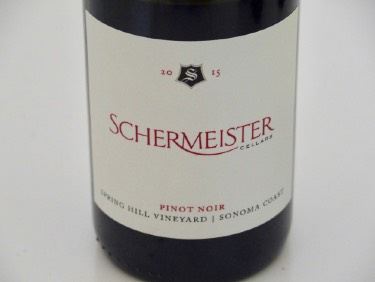 2015 Schermeister Spring Hill Vineyard Sonoma Coast Pinot Noir 14.5% alc., 100 cases, $57. Released September 2018. This vineyard is located in the far western part of the new Petaluma Gap AVA. Yields were a concentrated 0.8 tons per acre. Native yeast fermentation. Aged 18 months in French oak barrels, 50% new. Bottled unfined and unfiltered. · Moderately dark garnet color in the glass. Aromas of very ripe fruit including dark red and black berry with hints of balsam and vanilla. Plush on the palate in a sappy, saturated mid weight plus style, featuring flavors of blackberry, black raspberry, black tea and a compliment of oak vanillin. Nicely balanced, with some generosity on the intensely fruity finish. Considerably more giving and composed when tasted the following day from a previously opened bottle. Score: 92
Sinor-Lavallee, Arroyo Grande, CAWinemaker Mike Sinor worked for six small wineries in the 1990s to help pay for his schooling at Cal Poly SLO. While working for Robert Mondavi at Byron Winery in 1996, Mike and Cheri LaVallee Sinor got married in Burgundy, France. Soon after, they started Sinor-LaVallee. Mike subsequently helped launch Ancient Peaks Winery and remains on the team as Director of Winemaking. Mike and Cheri purchased the Bassi Vineyard in 2013. That same year, Mike decided to turn the Sinor- LaVallee brand into an all estate program. The vineyard, originally planted in 2001, is located alongside Highway 101 just 1.2 miles inland from Shell Beach. Half of the 30 acres are planted to 8 clones of Pinot Noir, and the remainder is split among Syrah, Chardonnay, Pinot Gris and Albarino. The vineyard is farmed organically with biodynamic input. Beginning in 2015, all grapes from Bassi Vineyard go into the 2,000 case production of Sinor-LaVallee. Mike was San Luis Obispo County’s Winemaker of the Year in 2012. A tasting room opened in early 2015 in Avila Beach (open Friday-Sunday afternoons). I first met Mike when he was the winemaker for Domaine Alfred (now Chamisal). The photo reflects our more youthful days. I followed Sinor-Lavallee beginning with the 2004 vintage and continuing until the 2014 vintage. With these wines reviewed here, I became re-connected with Mike’s production.
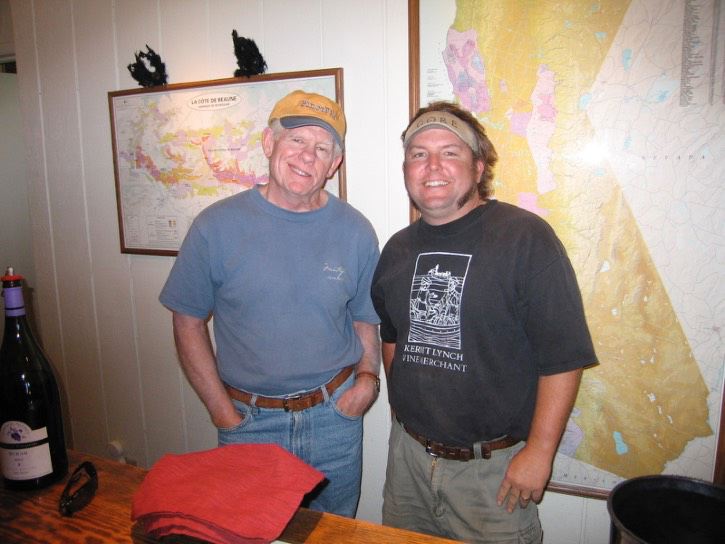
2015 Sinor-Lavalle Anniversary Cuvée San Luis Obispo County Pinot Noir 14.5% alc., 50 cases, $50. 100% Bassi vineyard fruit. Harvest Brix about 25º. All native primary and malolactic fermentation. 100% stem inclusion. Aged about 17 months in French oak barrels, no new barrel. Bottled unfined and unfiltered. · Moderately light garnet color in the glass. This wine needs time to unwind and yield its charms. Aromas of fresh black cherry and dark red berry with a touch of oak-driven vanilla, toast and marzipan. Smooth and sleek on the palate in a mid weight style, exhibiting expansive purple and blackberry fruits. The wine is giving now, with gentle tannins sound acidity. Score: 90
2016 Sinor-Lavallee Estate San Luis Obispo County Pinot Noir 14.5% alc., 519 cases, $30. Yield 3.74 tons per acre from Bassi Vineyard. Native and Assmanhausen yeast fermentation. Aged 11 months in mostly French oak barrels. Bottled with minimal filtration. · Moderate garnet color in the glass. Aromas of cherry, strawberry and tobacco leaf. Mid weight flavors of black cherry and purple berry with oak in the background. Easy to drink, with mild tannins, a velvety mouthfeel and some noticeable finishing length. Much better integration of oak when tasted the following day from a previously opened bottle. Score: 89
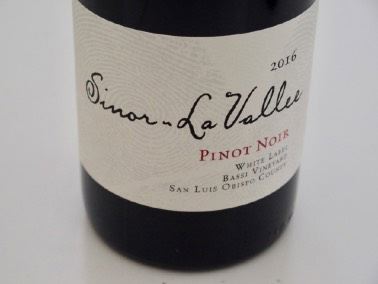 2016 Sinor-Lavallee White Label Bassi Vineyard San Luis Obispo County Pinot Noir 13.5% alc., 74 cases, $46. Ultra limited production wine that reflect a leaner expression of Bassi Vineyard. Clones, blocks, yeasts and barrels are selected to yield a wine with lower alcohol and higher acidity. Harvest Brix 21.0º. Clones 113, 114 and 115. 100% destemmed. Native and Assmanhausen yeast fermentation. Aged 18 months in French oak barrels, no new barrels. Bottled without fining or filtration. · Moderately dark garnet color in the glass. Pleasant, slowly emerging aromas of black fruits. A flood of black and purple berry flavors meet the mid palate and carry over through an intense finish. The satiny texture is welcoming and is the wine’s best feature. Nicely integrated tannins and a deft touch of oak. More open and delightful when tasted the following day from a previously opened bottle. Score: 92
2016 Sinor Lavallee Black Label Bassi Vineyard San Luis Obispo County Pinot Noir 16.7% alc., 96 cases, $46. An ultra limited production wine that offers a fuller expression of Bassi Vineyard. Clones, blocks, yeasts and barrels are chosen to yield a wine with higher alcohol and lower acidity. This wine is a powerful and rich expression of Bassi Vineyard. Yields 1.65 tons per acre. Last pick of Pinot Noir in this vintage. A blend of clone 667 and 777 with one barrel of 115. All lots inoculated with Assmanhausen yeast. Aged about 20 months in French oak barrels, 50% new. Bottled unfined and unfiltered. · Moderate garnet color in the glass. Reserved aromas of black raspberry and boysenberry with a bit of vanilla. Mid weight plus in concentration, featuring a plush mouthfeel, a full monty of blackberry fruit and firm, but engaging tannins. This wine reminds me of Meiomi Pinot Noir. When tasted the following day from a previously opened bottle, the seductive texture endured, but there was plenty of oak vanillin overlay. Remarkably, this wine seemed to be in balance from an alcohol perspective. Score: 90
2018 Sinor-Lavalle Ancestrale San Luis Obispo County Sparkling Pinot Noir 10.5% alc., 263 cases, $26. The front label shows an original oil painting done by Teddi Fuller of a bison skull that Mike’s late father shot and hangs at the winery. Fourth vintage for this “Pet Nat” sparkling wine created by “Methode Ancestrale.” Harvest Brix 17.8º. !00% clone 2A. Whole cluster pressed day of harvest. No SO2 or commercial yeast added. Pied de Cuve technique used to start fermentation. Tank fermented at about 55º F. Bottled 26 days after harvest. No SO2 or sugar added at bottling. Not disgorged. · Wine is under high pressure and bottle cap must be removed slowly as abundant bubbles emerge. White gold color in the glass. Very fragrant with aromas of apricot, nectarine, apple and botanical notes. Bubbles dissipate quickly. Quite enjoyable on the palate, with flavors of pineapple, lemon and white peach. A bone dry wine that has a little Muscat, Pinot Gris and Pinot Noir Blanc character. Not scored as I have never had a comparable wine, but I recommended it.
Tessier Winery, Healdsburg, CAOwner and winemaker Kristie Tacey specializes in Pinot Noir from the Santa Cruz Mountains, Russian River Valley and Anderson Valley. She launched Tessier Winery in 2009 and I have reviewed her excellent wines since that time. Visit www.tessierwinery.com or www.princeofpinot.com/winery/1538/.
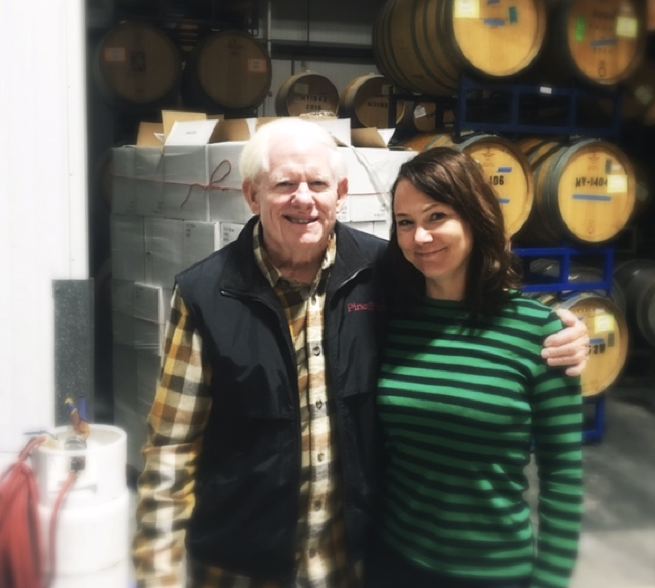
2016 Tessier Saveria Vineyard Santa Cruz Mountains Pinot Noir 13.2% alc., 150 cases, $50. 20% whole cluster. Native primary and secondary fermentations. Aged in French oak barrels, 50% one-year-old. · Moderately light garnet color in the glass. The nose offers aromas of red berry, sandalwood and whole cluster driven burnt tobacco. Plenty of stuffing to satisfy in a mid weight style offering flavors of black cherry and black raspberry with welcome spice and a hint of oak in the background. The tannins are well integrated, the texture is silky, and the finish satisfies with a spiced cherry gift. Score: 92
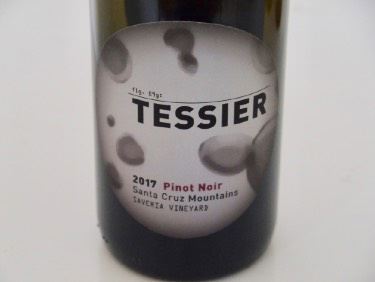 2017 Tessier Saveria Vineyard Santa Cruz Mountains Pinot Noir 12.9% alc., 174 cases, $52. Clone 667, 777 and 115. Organically farmed vineyard. 28% whole cluster. Aged in French oak barrels, 28% new. · Moderately light garnet color in the glass. Shy, but pleasing aromas of pine, burnt tobacco, cardamon and cherry. Delicious core of bright dark cherry and raspberry fruit flavors infused with exotic spices, and graced with floral goodness and a hint of tobacco and earth. Seamless, with gracious tannins and generous finishing length. Impressive in every way. Score: 94
2017 Tessier Filigreen Farm Vineyard Anderson Valley Pinot Noir 13.2% alc., pH 3.61, 73 cases, $60. Release mid-March 2019. The vineyard source is certified organic and biodynamically farmed. 72-year-old vines, Pommard clone. Harvest Brix 23.5º. 50% whole cluster. Aged in French oak barrels, 25% new. The wine is certified vegan. · Moderately light garnet color in the glass. Grounded aromas of fertile soil and mushroom. Sleek and refined in the mouth, with mid weight plus extraction of black cherry and blackberry fruits. Admirable harmony and fruit purity, with only a dusting of walnut-infused barrel magic and a dark fruited ending. Score: 92
Wayfarer Vineyard, Santa Rosa, CAWayfarer Vineyard is located in the Fort Ross-Seaview AVA. The vineyard is divided in twenty blocks and planted to multiple clones of Pinot Noir including 115, 667, 777, Pommard 4, Pommard 5, Swan, Mt Eden and Hirsch. I have been out to the vineyard with the winemaker Bibiana Gonzalez Rave who is also the winemaker for Cattleya and Pahlmeyer. It is an arduous but beautiful drive that takes about an hour from Sebastopol. Recently, just for fun, I joined a winemaker in tasting. 8 California Pinot Noirs from the 2016 and 2017 vintages that I had rated 94 or better. The wines were Brooks Note Weir Vineyard, Loring Rosella’s Vineyard, En Garde Pleasant Hill Vineyard, Benovia Tilton Hill Vineyard, Foursight Charles Vineyard Paraboll, Fulcrum Gap’s Crown Vineyard and ROAR Garys’ Vineyard.The 2016 Wayfarer Vineyard Pinot Noir was the favorite among all of these wines for both myself and the winemaker. This wine is a blend of grapes from the entire vineyard. Visit www.wayfarervineyard.com or www.princeofpinot.com/winery/2394/. The outstanding Wayfarer Chardonnay is reviewed later in this issue.
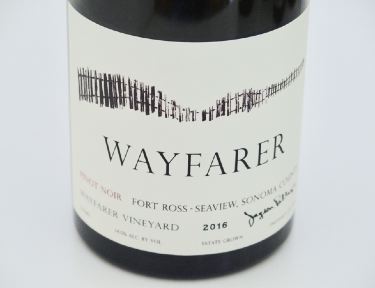 2016 Wayfarer Wayfarer Vineyard Fort Ross-Seaview Sonoma Coast Pinot Noir 14.5% alc., pH 3.55, 1,500 cases, $90. Grapes are picked and delivered to the winery before sunrise, then hand-sorted and de-stemmed before transferring to tank. 5 to 7-day cold soak followed by more than two weeks of native fermentation. Free-run juice was aged in French oak barrels, 44% for 15 months. · Moderate garnet color in the glass. Everything you can ask for in a Pinot Noir, with lovely aromas of cherry, raspberry, dark rose petal and sous-bois. A cornucopia of up-front pleasure in a mid weight style, featuring earth-kissed flavors of black cherry and black raspberry and a hint of racy spice, framed by comforting tannins. Velvety in the mouth with an appealing cut of acidity on the extremely long, peacock tail finish. A celestial wine with the balance to achieve immortality. Score: 97
More Wines
2016 Carmel Road Monterey Pinot Noir 13.8% alc., $25, screw cap. Sourced from SIP Certified vineyards and produced at a winery in the Arroyo Seco AVA. Aged 9 months in French oak barrels, 13% new. · Moderately light garnet color in the glass. The nose leads with aromas of forest, cherry and strawberry. Heavily infused with oak in a mid weight style, featuring a nucleus of cherry fruit encased in gentle tannins and finishing with a red cherry flourish and a trail of toasty, vanillin oak. Score: 87
2016 Ellen Redding Stubbs Vineyard Marin County Pinot Noir 13.8% alc., 80 cases, $42. This wine is an ode to Patrick McNeil’s grandparents and the years leading up to their wedding at St. Mary’s Church in Nicasio, California. Each new vintage and colorful envelop reflecting letters sent by Joseph Dennis McNeil to Ellen Josephine Redding by U.S. mail from 1925 to 1928. Stubbs Vineyard is located 13 miles from Tomales Bay and is farmed organically and sustainably. Clone 115, yield 2 tons/acre. 7-day cold soak, native primary and secondary fermentations, aged in 2 neutral and 1 once-used French oak barrels. · Moderately light garnet color in the glass. Aromas of black cherry, underbrush and spice rise from the glass. The mid weight nucleus of black cherry fruit is expansive from entry through the succulent finish. The mouthfeel is cohesive, the tannins are suave, and the overall impression is one of harmony. Score: 93
2016 Kukeri Lakeville Vineyard Petaluma Gap Pinot Noir 14.4% alc., pH 3.56, TA 0.62, 175 cases, $48. Double Gold from the 2019 San Francisco Chronicle Wine Competition. 100% Martini clone. 100% destemmed, 3-day cold soak, fermented with ‘prise de mousse’ yeast, and aged 17 months in French oak barrels, 40% new. · Moderate garnet color in the glass. Aromas of well-ripened fruit including boysenberry and raisin, with added aromas of spice, fertile earth and subtle oak. Creamy in the mouth, with a mid weight core of very ripe purple and black fruits, even roasted in character. There is the typical dark chocolate notes of the Martini clone. Oak contributes some marzipan and spice notes most evident on the robust finish. Score: 89
2016 MacRostie Sonoma Coast Pinot Noir 14.5% alc., 3,184 cases, $34, screw cap. Vineyarddesignate caliber lots are included in this wine. There is a focus on Thale’s Estate, Wildcat Mountain, Champlin Creek and Sangiacomo vineyards. 20% whole cluster. Two-week fermentation followed by aging in French oak barrels, 22% new, for 10 months. · Light ruby red color in the glass. Aromas of cherry, baking spice and toasty oak are most appealing when the cork is first pulled. A gentle, lighter-styled wine with flavors of red cherry and strawberry and no apparent oak on the palate. Sleek and elegant, with gossamer tannins and a little finish. An easy-to-cozy-up-to back porch Pinot. Score: 89
2015 Nelson Hill Deep End Vineyard Anderson Valley Pinot Noir 14.5% alc., $48. Barbara and Greg Hill farm their estate Deep end Vineyard planted to 114, 115, 777 and Pommard clones. · Moderate garnet color in the glass. Aromatic nose offering scents of black cherry, strawberry, spice and earth. Even more appealing on the palate, offering a complex of flavors including dark cherry, raspberry, dried herbs, tobacco and spice. More desirable when tasted the next day from a previously opened and re-corked bottle, showing persistent aromatic joy and a deep cherry flavor. Score: 92
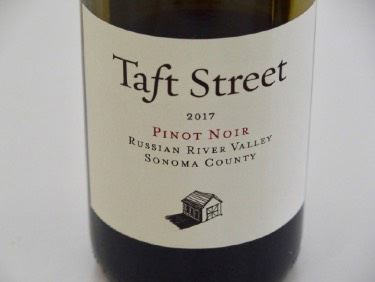 2017 Taft Street Russian River Valley Pinot Noir 14.1% alc., 990 cases, $28. Sourced from Skikos Vineyard (clone 667) and Winkler Vineyard (clone 23), both in the Russian River Valley. A 5-day cold soak was followed by inoculation with proprietary yeast and then open-top tank fermented at cool temperatures. The wine was aged in French oak barrels, 30% new, for 10 months. · Moderately light garnet color in the glass. Enticing aromas of Bing cherry, dark raspberry, baking spice, cola and graham. A quintessential Russian River Valley Pinot Noir, featuring flavors of dark red and black cherry, cola, spice, dark cocoa and a hint of toasty oak. Nicely composed and welcoming, with some finishing generosity. A fantastic value. Tasted twice with the same results. Score: 92
Recently Tasted California Chardonnay
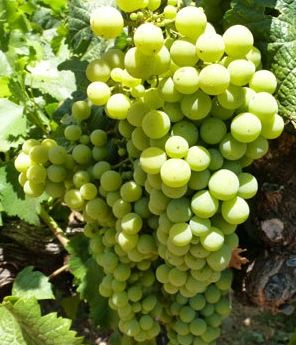 Chardonnay continues to be by far the most popular varietal among American wine consumers. According to estimates by The Nielsen Company, Chardonnay represented an estimated 19 percent of table wine volume purchased in U.S. food stores in 2017. Sales of this leading varietal increase every year. In 2017, the state had 94,452 acres planted to Chardonnay. Monterey County led California counties with 16,969 acres and Sonoma County was a close second at 15,617 acres. Most Chardonnay vineyards were uprooted during Prohibition when growers replaced them with thick-skinned red varieties that could be shipped cross country. Small plantings of Wente Chardonnay survived Prohibition. Ernest and Herman Wente took over the family business after Prohibition and developed the Wente Chardonnay clones that completely transformed California’s Chardonnay wine landscape. Today, over 80 percent of Chardonnay produced in California comes from some version of the Wente clone. There are at least 34 different varieties of Chardonnay identified in France and these so-called “Dijon” clones have been exported all over the world. The most common Chardonnay Dijon clones are 96 and 95, both traced to Meursault, France, and 76, traced to the Saone et Loire region of France. The most popular style of California Chardonnay is whole cluster pressed and barrel fermented with malolactic fermentation occurring in barrel, along with aging sur lie with battonage. The combination of malolactic fermentation and new French oak barrels leads to richer wines with a noticeably creamy texture. There are many variations of this theme and winemaker decisions and manipulations generally play a larger role in the vinification of Chardonnay than of Pinot Noir. It is a whole lot easier to find superb California Chardonnay than exceptional California Pinot Noir. California Chardonnay quality is so high that the consumer only needs to discover a winemaking style that appeals.
2016 Blagden Sangiacomo-Roberts Road Vineyard Sonoma Coast Chardonnay 14.2% alc., pH 3.56, TA 0.57, 120 cases, $42. Release spring 2019. Robert Young clone 17. Barrel fermented with native yeasts, inoculated for 100% malolactic fermentation, aged 16 months in French oak barrels, 20% new. · Moderately light golden yellow color in the glass. The nose leads with aromas of lemon oil, warm biscuit, vanilla and malt. Righteous, ripe fruited flavors of lemon, pineapple, yellow peach, and kiwi. Engaging and expansive on the palate in a Caliesque style. Score: 92
2015 Boèhme English Hill Vineyard Sonoma Coast Chardonnay 13.7% alc., 85 cases, $49. Released November 1, 2018. Wente selection. Whole cluster pressed, barrel fermented in seasoned oak barrels, and aged in French oak on the lees for 20 months with complete malolactic fermentation prior to bottling. · Moderate golden yellow color in the glass. Intriguing aromas of lemon, buttery brioche, juniper and a hint of yeast. Discretely rich in style, offering flavors of lemon, pineapple and dried yellow peach. Bright acidity tempers the richness of fruit and the wine finishes long with abundance of citrus goodness. Score: 93
2015 Boèhme Taylor Ridge Vineyard Sonoma Coast Chardonnay 13.7% alc., 75 cases, $49. Released November 1, 2018. Wente selection. Yield 0.57 tons/acre. Whole cluster pressed, barrel fermented, and aged on the lees 20 months in French oak barrels with complete malolactic fermentation before bottling. · Moderately light golden yellow color in the glass. Delicate aromas of lemon-lime, ripe apple and ocean breeze. Refined and seamless in the mouth, featuring a citrus fruit core accented with oak-driven toast, caramel and vanilla, Good cut with a quenching finish makes this wine an ideal food companion. Score: 93
2017 Cuvaison Napa Valley Los Carneros Chardonnay 14.1% alc., pH 3.62, T 0.60, $25. Grapes were picked from the Los Carneros estate the same day that the Nuns fire began and spared any damage. 100% malolactic fermentation, aged 11 months in French oak barrels, 25% new. · Moderately light golden yellow color in the glass. This wine needs time to unfold. It lacks appeal upon opening but blossoms over time showing delicate aromas of lemon and pineapple.. Modest richness and creaminess, featuring a core of citrus fruits with a bit of pastry creme. Crisp and clean, in an easy drinking style. Score: 89
2016 E16 Bacigalupi Vineyard Russian River Valley Chardonnay 14.2% alc., pH 3.59, TA 0.50, 279 cases, $. Fruit harvested from a block planted in 1976 with clone 4. Barrel fermented and aged 18 months in French oak barrels, 30% new. · Light golden yellow color in the glass. Reserved, but teasing aromas of lemon pie, butter, biscuit and clean air after a rain. The appealing lemon and spice flavors gain traction over time in the glass. There is adroit oak treatment and an oily texture. The overall impression is one of harmony. I have tasted many Chardonnays from the Bacigalupi Bloom Ranch and this wine shows the character inherent in that vineyard. Score: 92
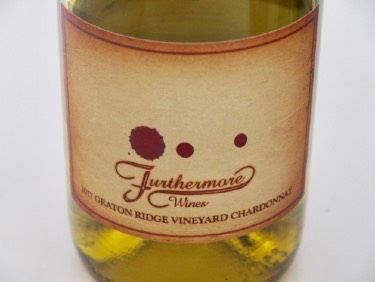 2017 Furthermore Graton Ridge Vineyard Russian River Valley Chardonnay 14.2% alc., 150 cases, $45. · Light golden yellow color in the glass. The nose merges aromas of grilled lemon and peach with toasty oak. Soft and polished, with pleasure-seeking flavors of lemon, pineapple, yellow apple and nectarine with a hint of saltiness. This wine’s best features are its round mouthfeel and the tight lemony finish. Score: 93
2017 Joseph Phelps Freestone Vineyards Sonoma Coast Chardonnay 13.5% alc., 2,400 cases, $60. Aged 13 months in 42% new and 58% once-used French oak puncheons and barrels. · Moderately light golden yellow color in the glass. Reserved aromas of lemon drop, pomelo and peach. A citrus-driven flavor profile with a slight botanical tone. Slightly viscous in mouthfeel, with some length to the slightly tart, yellow grapefruit driven finish. Score: 90
2016 Long Meadow Ranch Anderson Valley Chardonnay 13.5% alc., $42. Estate grown. · Moderately light golden yellow color in the glass. Pleasing aromas of lemon curd, pineapple, buttered toast, salted caramel and vanilla. Endowed with somewhat rich citrus fruit flavor with undertones of vanilla and salinity. Viscous on the palate, with acidity nicely folded in and a good cut on the dry finish. Score: 91
2017 Morgan Tondre Grapefield Santa Lucia Highlands Chardonnay 14.1% alc., pH 3.17, TA 0.79, 96 cases, $44. Clone 548. Vineyard originally planted in 1997 and farmed by veteran grower Joe Alarid. Whole cluster presserd, barrel fermented with Montrachet yeast, 96% malolactic conversion, aged 10 months in French oak barrels, 33% new. · Moderately light golden yellow color in the glass. Enchanting aromas of lemon curd and pineapple. Welcome richness of citrus and yellow apple flavor, yet crisp, crunchy and fresh. Admirable barrel management with some echos of citrus on the pleasing finish. Score: 93
2017 Morgan Double L Clone 15 Santa Lucia Highlands Chardonnay 14.1% alc., pH 3.24, TA 0.71, 101 cases, $44. Gently whole cluster pressed, fermented in French oak, 95% malolactic conversion, and aged 10 months in French oak barrels, 33% new. · Moderately light golden yellow color in the glass. A classic style, offering aromas of lemon oil, spiced apple, buttery brioche and a hint of flint. Rich fruit flavors of lemon, pineapple, and yellow apple, with metallic and botanical tones. Judicious use of oak, with bright acidity, and an agreeable lemony finish. Score: 92
2016 Neely Spring Ridge Vineyard Home Block Santa Cruz Mountains Chardonnay 14.4% alc., 56 cases, $52. Release March 25, 2019. · Moderate golden yellow color in the glass. Shy aromas of dried herbs, crushed seashells and warm biscuit. Layers of well-ripened, oxidative fruits including fig and stewed apple with accents of salted caramel and honey. Score: 88
2016 Neely Spring Ridge Vineyard Bee Block Santa Cruz Mountains Chardonnay 14.6% alc., 237 cases, $42. Release March 25, 2019. · Moderate golden yellow color in the glass. Reserved aromas of ocean breeze, chalkboard and nuts. Tastes like an aged Chardonnay, with flavors of stewed citrus fruits, sherry and dried herbs backed by a touch of oak. Score: 88
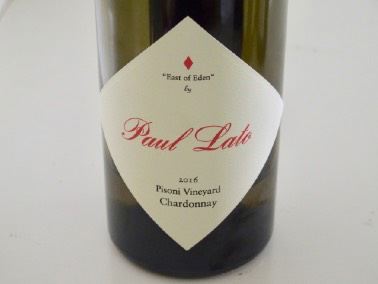 2016 Paul Lato “East of Eden” Pisoni Vineyard Santa Lucia Highlands Chardonnay 14.5% alc., $80. · Moderately light golden yellow color in the glass. Lovely aromas of peach and buttery brioche. Slightly creamy and invigorating in the mouth, with sterling flavors of lemon, pineapple, yellow peach and pear. Full of sunshine and a wine to cherish. Welcome to Hotel California. Score: 94
2017 ROAR Rosella’s Vineyard Santa Lucia Highlands Chardonnay 14.3% alc., pH 3.47, TA 0.59, 107 cases, $45. Hyde, Monty and Dijon 96 clones. Aged in French oak barrels, 38% new. · Moderate golden yellow color in the glass. Bright and clean aromas show up on the nose, including citrus, poached pear, banana and petrichor. Demure, but seductive in the mouth, featuring flavors of lemon, pear and melon and gracious oak. Crisp and sleek, exhibiting impeccable balance. Score: 93
2017 ROAR Sierra Mar Vineyard Santa Lucia Highlands Chardonnay 14.5% alc., pH 3.54, TA 0.61, 175 cases, $45. Hyde and Monty clones. Aged in French oak barrels, 40% new. · Moderate golden yellow color in the glass. Subtle lemon and flint aromas with oak-driven toast and char that integrates with swirling. Flashy and delicious on the palate, featuring ripe flavors of lemon, pear and particularly pineapple with a modicum of oak in the background. Slick in texture with welcome spice, and some length on the slightly flinty finish. Score: 92
2017 ROAR Soberanes Vineyard Santa Lucia Highlands Chardonnay 14.1% alc., pH 3.53, TA 0.54, 115 cases, $45. Monty clone. Aged in French oak barrels, 33% new. · Moderate golden yellow color in the glass. Demure aromas of lemon curd, pineapple and cold steel. An austere style, featuring flavors of citrus, pear and vanilla. Silken and soft with a modest finish. Score: 90
2016 Roessler Wine Cellars Big Bend Sonoma Coast Chardonnay 14.1% alc., pH 3.25, TA 0.70, $30. Sourced from two vineyards with the majority from a cool Russian River Valley site and the remainder from a Petaluma Gap vineyard. Whole cluster pressed, barrel fermented with organic French yeast, native malolactic fermentation, and aged 18 months in French oak barrels, 25% new. · Moderately light golden yellow color. Inviting scents of lemon, mango, buttery brioche and nutty oak. The flavor profile is citrus driven with a note of vanilla in the background. Soothing in texture, with discreetly bright acidity. Score: 91
2015 Sinor-LaValle San Luis Obispo County Chardonnay 14.2% alc., $26. · Moderate golden yellow color in the glass. Aromas of peach, ripe pineapple, kiwi, and vitamins. Fuller-bodied in style, with bolder flavors of lemon curd, pineapple, honey, tropical fruits and toasty oak. Slightly viscous in the moth, with a fruit-filled finish. A solid wine that aims to please only lacking a bit of zip and zing. Score: 89
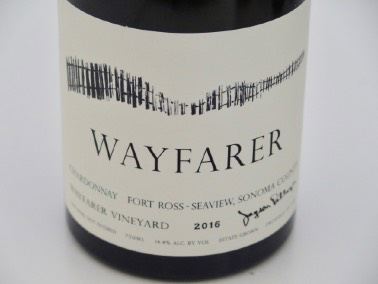 2016 Wayfarer Wayfarer Vineyard Fort Ross-Seaview Sonoma Coast Chardonnay 14.4% alc., pH 3.28, 725 cases, $80. Berlenbach Old Wente, Hyde Old Wente, Mt Eden, Dijon 95. Whole cluster gently pressed, barrel fermented and aged in French oak barrels, 76% new. Native yeasts slowly guided alcoholic fermentation, with careful lees stirring until malolactic fermentation completion. Aged 15 months and bottled unfined and unfiltered. · Moderate golden yellow color in the glass. An exceptional, connoisseur’s wine that leads with aromas of lemon, pineapple, salt air, wet stones and the slightest matchstick. Slightly creamy in the mouth, with flavors of lemon wafer and pineapple. Easy to cozy up to with a modicum of oak overlay. Keeps giving the longer it opens in the glass. Score: 94
Pinot Briefs
Healdsburg’s Gracianna Winery Under Water after the Flood The recent flooding in the Russian River Valley left the Gracianna Tasting Room practically submerged and devastated. The winery is located in a low-lying area on Westside Road just west of the Russian River. 4,400 cases of wine were stored in the cellar including large format bottles, library wines and the owner’s personal collection. Wine that was untouched by water was saved and moved with the help of the McWilliams Family at Arista. The flood was the worst since 1995. Read the full story at www.pressdemocrat.com. Wineries in Sebastopol’s The Barlow damaged by the flood include Pax, Friedeman Wines and McPhail. Kosta Browne was spared. 2019 Sonoma County Barrel Auction This year’s Auction will be held May 3, giving trade buyers the chance to bid on lots ranging from 5 to 20 cases. The wines will ultimately reach the cellars of collectors and trade customers. The Auction traditionally honors Icons who are vintners who have played a significant role in the winemaking history of Sonoma County. this year’s Icons are Margo Van Staaveren of Chateau St. Jean and Rod Berglund of Joseph Swan Vineyards. New this year are awards given to Innovators, forward-thinking visionaries in the Sonoma County wine business. Honorees include The Duncan Family of Silver Oak Cellars and Ron Rubin of Ron Rubin Winery. Winemaker Adam Lee Looks to Concrete Aging for Pinot Noir A recent article in the Press Democrat profiled Adam and focused on his new Pinot Noir project, Clarice Wine Co. This unique winery approach enrolls a limited number of subscribers who pay $960 annually to receive a case of wine from the Santa Lucia Highlands three times a year. In return, they receive more interaction with Adam through a private online web forum. Adam has acquired concrete tanks to both ferment and age Pinot Noir in place of more expensive French oak barrels. Whether this new technique will break up the long-standing marriage of Pinot Noir and oak remains to be seen. New Winemaker at White Rose Estate Oregon native Tresider Burns is the new winemaker at this Dundee Hills producer of Pinot Noir. After his enology training at Oregon State University, he was an assistant winemaker at Brittan Vineyards and also worked at Lemelson. How Many Aroma Descriptors are Possible? An article by Dwight Furrow in the Edible Arts blog at www.foodandwineaesthetics.com, discussed the description of wine aromas with reference to Gordon Shepherd’s book, Neuroenology: How the Rain Creates the Taste of Wine. Shepherd believes that most people can only identify three distinct aromas in wine, with many only able to detect one or two aromas. Furrow challenges this presumption because wine tasters do not base their aromatic description on one sniff of the wine. He reasons that experienced wine tasters can detect multiple aromas because they perform multiple inhalations over time. This is the way I review wine. That is why you will see up to five or six aroma descriptions in some wines I review. More Understanding from Neuroenology Gordon Shepherd, a Yale neuroscientist, wrote Neuroenology: How the Brain Creates the Taste of Wine, and this book has spawned considerable discussion. An article appeared at www.foodandwine.com that pointed out Shepherd’s argument that wine tasting actually stimulates the brain more than listening to music or working on a complicated math problem. Shepherd says, “Tasting wine engages more of our brain than any other human behavior.” Male & Female Judges Assign Same Ratings to the Same Wines A recently released study from a professor Manuel Malfeito Ferreira at the University of Lisbon and US financial analyst Jeff Bodington, published in The Journal of Wine Economics, concluded that men and women assign much the same ratings to the same wines. Ferreira was quoted, “The difference between men and women when it comes to appreciating and judging wine is minimal or absent.” Bodington pointed out that the conclusion does not imply that genders have the same tastes or preferences when not judging. Read the article at https://www.meininger.de/en/wine-business-international/do-men-and-women-assign-different-winescores. More and More Consumers Buy Wine Directly A recent article at, http://www.sfexaminer.com/wine-drinkers-opting-skip-stores-direct-shipping/ reported the results of the 2019 Direct to Consumer Wine Shipping Report sponsored by Sovos and Wines Vines Analytics. Direct to consumer (DTC) shipping increased 12 percent in 2018 from 2017. Consumers spent $3 billion to purchase wine that was shipped to them directly from the winery. This accounted for 10 percent of all off-premises sales of wine domestically. Oklahoma lifted its ban on DTC shipping in 2018 so there are only four states that still prohibit it (Utah, Kentucky, Mississippi and Alabama). California is the most common destination followed by Texas, New York, Washington State and Florida. Sonoma County now ships more wine by volume than Napa County, and the average Sonoma County bottle price is under $30 compared to Napa’s average bottle price of over $67. Oregon and Washington State had increases in volume shipped of 19 percent and 18 percent respectively. 80 percent of the nearly 10,000 wineries in the U.S. doing most of the DTC shipping were small in size, producing under 5,000 cases a year. The top shipped varietals in descending order were Cabernet Sauvignon, Pinot Noir, red blends, Chardonnay and Zinfandel. Pinot Noir took over the second place in 2017. In 2018, Rosé shipments grew 24 percent in volume and 29 percent in value. Nielsen Total U.S. Off Premise Sales by Varietal
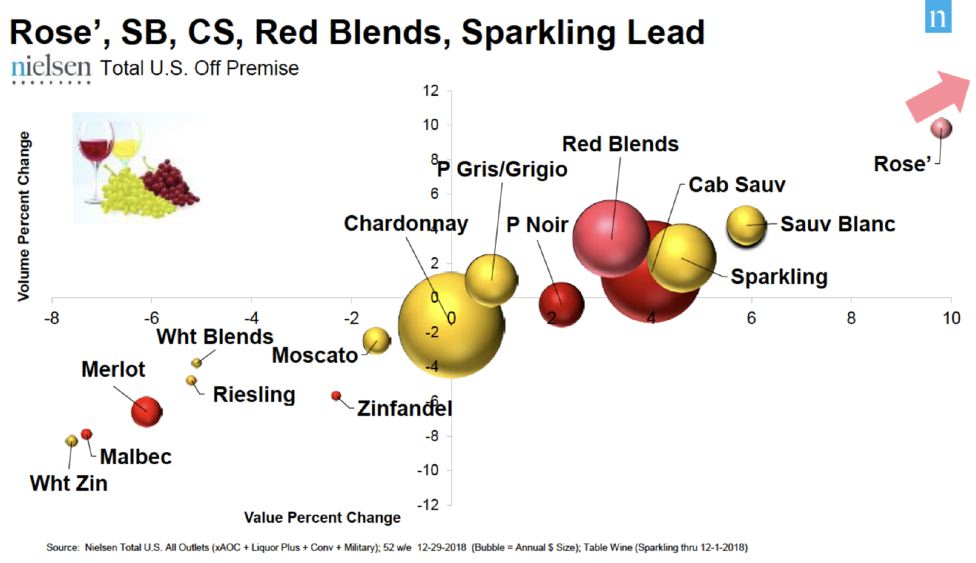 More Discussion on Wine Scoring I recently wrote a feature article in the PinotFile on the declining enthusiasm by the consumer for wine scores as an indicator of wine quality. David Morrison, who writes an excellent wine blog called The Wine Gourd at www.winegourdblogspot.com, posted on February 18, 2019, “If not scores or words to describe wine quality, then what?” He points out that wine-quality scores give the illusion of being mathematical without having any useful mathematical properties. He says, “The apparent precision of the numbers gives an illusion of accuracy.” Practically speaking, quality scores are nothing more than a personal opinion used to rank wines. Morrison goes on to discuss some of the suggestions in the public arena that could replace scores and descriptions, none of which, in my opinion. have a chance of being adopted. Willamette: The Pinot Noir Auction This trade-only event on April 5-6 is a 2-day series of special tastings and gatherings, culminating in a live auction. Attendees can bid on and acquire 85 one-of-a-kind- Pinot Noir lots from the 2017 vintage. There will also be six collaborative Chardonnay lots. All lots are produced in quantities of 5, 10 or 20 cases. The wines are eventually made available to consumers by the winning bidders. All proceeds from the auction support the marketing, branding and education efforts of the Willamette Valley Wineries Association. 73% of grapes grown in the Willamette Valley are Pinot Noir and 70% of wineries there produce less than 5,000 cases a year. 50% of grapes are estate grown. England the Next Big Still Pinot Noir Region? Pinot Noir is now the UK’s most widely planted grape according to WinesGB. Most of UK’s Pinot Noir goes into producing English sparkling wine. As reported in www.thedrinksbusiness.com, Sam Linter of Bolney Wine Estate said that Pinot Noir could potentially become the UK’s leading still wine. James Lambert, director of The Lyme Bay Winery, believes there will be an emphasis on still wine in the UK over the next decade. Dogs Used to Detect TCA As reported in Wine Industry Insight, http://wineindustryinsight.com/? p=97617, in February 2019, TN Coopers, a Chilean-based company has been using specially trained canines to discover TCA and other wine-ruining chemicals that may have contaminated shipments of oak stave blanks from around the world. Their initiative is dubbed Natinga Project. Now TN Coopers is bringing some of their Natinga Project Dogs to an on-site winery tour in the U.S. Labrador retrievers, former drug-sniffing dogs, are being used to detect TCA and TBA. Winery Loyalty Programs Trending Loyalty programs that reward customers for spending money on wine are replacing wine clubs at some California wineries. Accumulated points can be redeemed for private tastings and special events. Wineries using loyalty programs now include Jordan Vineyard and Winery, Francis Ford Coppola Winery, DeLoach Vineyards, and the portfolio of Foley Food & Wine Society. Percentage Change in Per Capita Ethanol Consumption in the U.S., 1977-2016
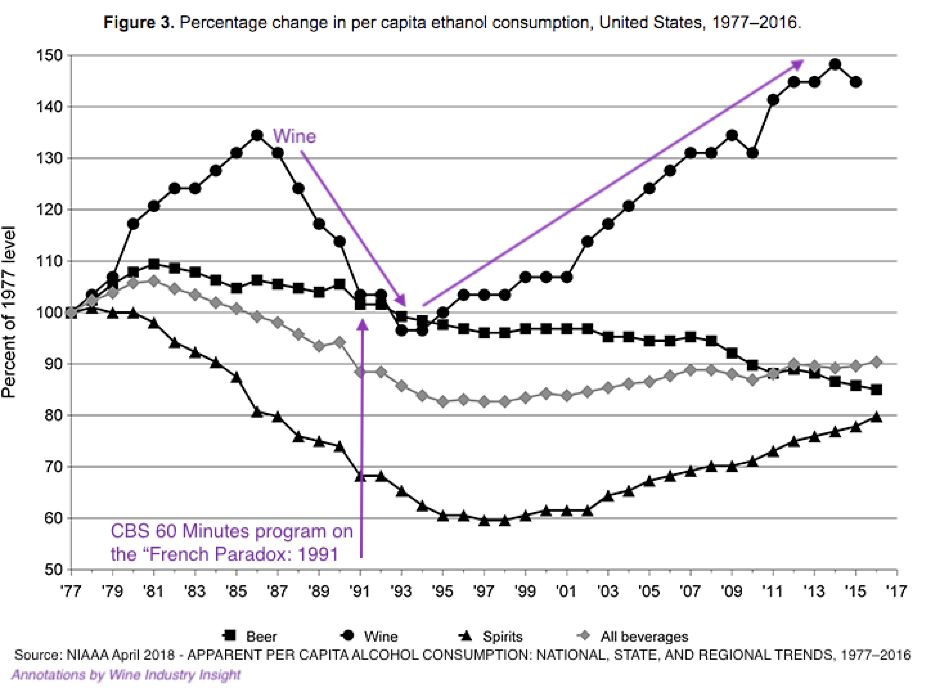 Vintage Wine Estates Purchases Laetitia Vineyard & Winery Vintage Wine Estates has been buying California Central Coast wineries recently, including Clayhouse Wines, Alloy Wine Works, and Qupé Winery. Records indicate the 1,986-acre real estate transaction alone totaled at least $22.3 million. The purchase also included a production facility, inventory, vineyards, tasting room and estate guest house. Current head winemaker Eric Hickey will stay on as part of the winemaking team. Travel Personalization Platform for Santa Ynez Valley Visit the Santa Ynez Valley (visitsyv.com) has launched a new partnership with Utrip enabling visitors to create unique, personalized itineraries for their trips to the region. The experience is available at www.mytrip.visitsyv.com. With over 100 wineries in the Santa Ynez Valley, planning a trip can be daunting. With Utrip’s technology, visitors can more easily find what most interests them to plan an itinerary that will ensure they get the most out of their visit. Santa Barbara Futures Return Perhaps you remember several years ago when Doug Margerum, then the owner of the Wine Cask wine shop and restaurant, organized an annual features offering of Santa Barbara County wines offered through a catalog. Consumers were able to buy pre-release wines at a discounted price. Many brands became well known as a result such as Brewer-Clifton, Paul Lato and Tensley. Margerum is now organizing a Santa Barbara County Vintners Futures Tasting March 29-31 at the Alisal Guest Ranch and Resort in the Santa Ynez Valley. An all-inclusive weekend package or single event tickets are available. All profits will fund Vino de Suenõs, Santa Barbara Vintner’s program that provides assistance to vineyard workers and their families. 84 wines from 40 wineries will be offered, with the wines representing unique cuvées that will not be commercially available. At the Grand Tasting on Saturday, the wines will be sold with a 3-bottle minimums at a 20 percent discount. The event will also feature a seminar on Saturday featuring the wines of Bien Nacido and Sanford & Benedict vineyards. For tickets to individual events, visit www.sbcountywines.com. For Alisal’s weekend package, visit www.independent.com/futures19. Winesong! 2019 The 35th Annual Winesong! weekend event on the Mendocino Coast will take place September 6-7, 2019. All proceeds are used to enhance equipment, facilities and services at the Mendocino Coast District Hospital. This two-day festival features special wines from Napa and Sonoma County, Oregon and beyond. Local breweries and cideries and regional culinary vendors also participate in in the name of charitable giving. The event will start on Friday, September 6, with A Pinot Noir Celebration that includes over 35 wineries pouring at the Little River Inn. On Saturday, September 7, the Winesong! Wine & Food Tasting will take place at Fort Bragg’s Mendocino Coast Botanical Gardens from 11-2. The centerpiece of Winesong! is the Charity Auction, which will be held on Saturday, September 7, from 11-3 (Silent Auction) and 2-5 (Live Auction). General admission is $125 and includes festival seating round the Live Auction tent. Auction Reserve tickets are $225 and include reserved seating and reserved parking. A full list of events and ticket purchase information is at www.winesong.org/events/purchase-tickets/.
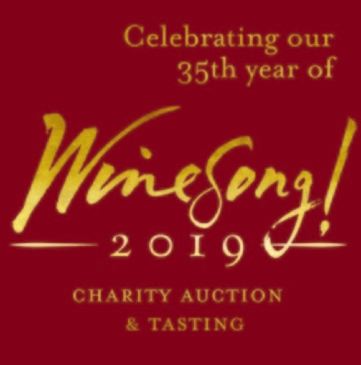 Wine History Project Since 2015, historians are preserving the history of San Luis Obispo vintners and winemakers and the history of Central Coast wine country. The Project collects and archives two centuries worth of, historical photographs, documents, news releases, recordings and videos. Beginning March 1, they offered an exhibit, “Wine Becomes Art,” a display of original artwork and hand-etched wine bottles, and starting March 4, a “Corkscrew Development Exhibit.” These exhibits and others are located at the Wine History Project offices at 3592 Broad Street, San Luis Obispo, CA and at the San Luis Museum of Art (SLOMA). For more information, visit www.winehistoryproject.org. “What happened to those old 45’s? They were such a part of our lives.” |